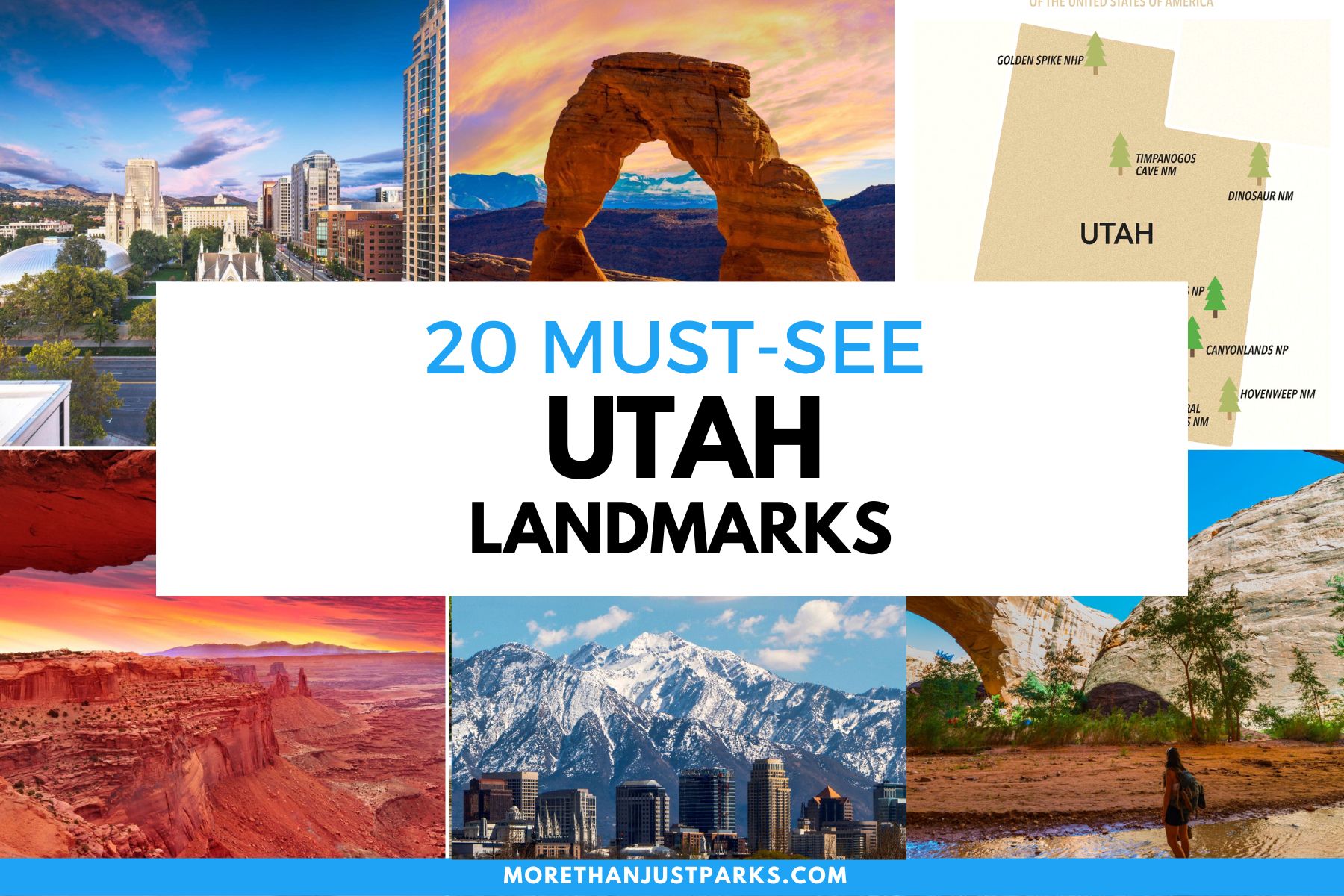
Article Summary: Utah Landmarks
Utah Landmarks. More Than Just Parks has 20 incredible must-see sites for you to visit.
There’s so much more to this exciting place than the Utah Jazz. In this article, we’ll familiarize you with the incredible landmarks located in the Beehive State.
We’ve got incredible places, iconic memorials, fascinating museums, epic monuments and so much more.
We’re going to give you our list of the Top 20 Landmarks In Utah.
So, What Is A Landmark?
Well, it’s a place of “a special character or special historical or aesthetic interest or value as part of the development, heritage, or cultural characteristics of a city, state, or nation.”
Why visit these places? Because landmarks connect us to the past. Through visiting these wonderful places where history occurred we find our roots. It allows us to feel like we are a part of something much bigger than ourselves.
And, speaking of history, did I mention that I taught the subject? I spent a lifetime teaching about the history behind many of these momentous sites. Then I got to see them firsthand. And now I’m sharing the stories of these incredible places with you. It doesn’t get any better than that!
So, without further ado, let’s dive in.
Utah Landmarks
Some Fascinating Facts About Utah
Here’s some interesting facts about Utah:
- Utah is known as the “Beehive State” because it was founded by Mormon pioneers who believed in hard work and industry, like bees in a hive.
- Salt Lake City, the capital and largest city in Utah, was founded in 1847 by Brigham Young and other Mormon pioneers. The city is named after the nearby Great Salt Lake, which is the largest saltwater lake in the Western Hemisphere.
- Utah is home to five national parks: Arches, Bryce Canyon, Canyonlands, Capitol Reef, and Zion. Each park offers stunning landscapes and outdoor recreational activities like hiking, camping, and rock climbing.
- The state’s economy is heavily influenced by the mining industry. Utah is rich in natural resources like copper, gold, silver, and coal.
- Utah is one of the driest states in the U.S., with an average annual precipitation of just 12 inches. However, the state is also known for its world-class skiing and snowboarding resorts, which receive an average of 500 inches of snowfall per year.
- The Sundance Film Festival, one of the largest independent film festivals in the world, takes place annually in Park City, Utah.
- The Great Salt Lake is so salty that people can easily float on its surface. In fact, it’s almost 10 times saltier than the ocean.
- The Utah Jazz, an NBA team based in Salt Lake City, is the only major professional sports team in the state.
- The Mormon Tabernacle Choir, one of the most famous choirs in the world, is based in Salt Lake City and has been performing for over 100 years.
- Utah was the 45th state to join the United States, admitted on January 4, 1896.

We’re Excited To Share Our List Of The Top 20 Utah Landmarks With YOU
Called “Four Corners,” it’s the only place in the country where four states come together! Utah has three major geographic areas: the Rocky Mountains, the Basin and Ridge Region, and the Colorado Plateau. The Rocky Mountains region runs from northeastern Utah through the center of the state.
But the state also features some amazing landmarks. More Than Just Parks is excited to share our list of the Top 20 Utah Landmarks with you. And we’re kicking it off at #20 with St. Mark’s Episcopal Cathedral.
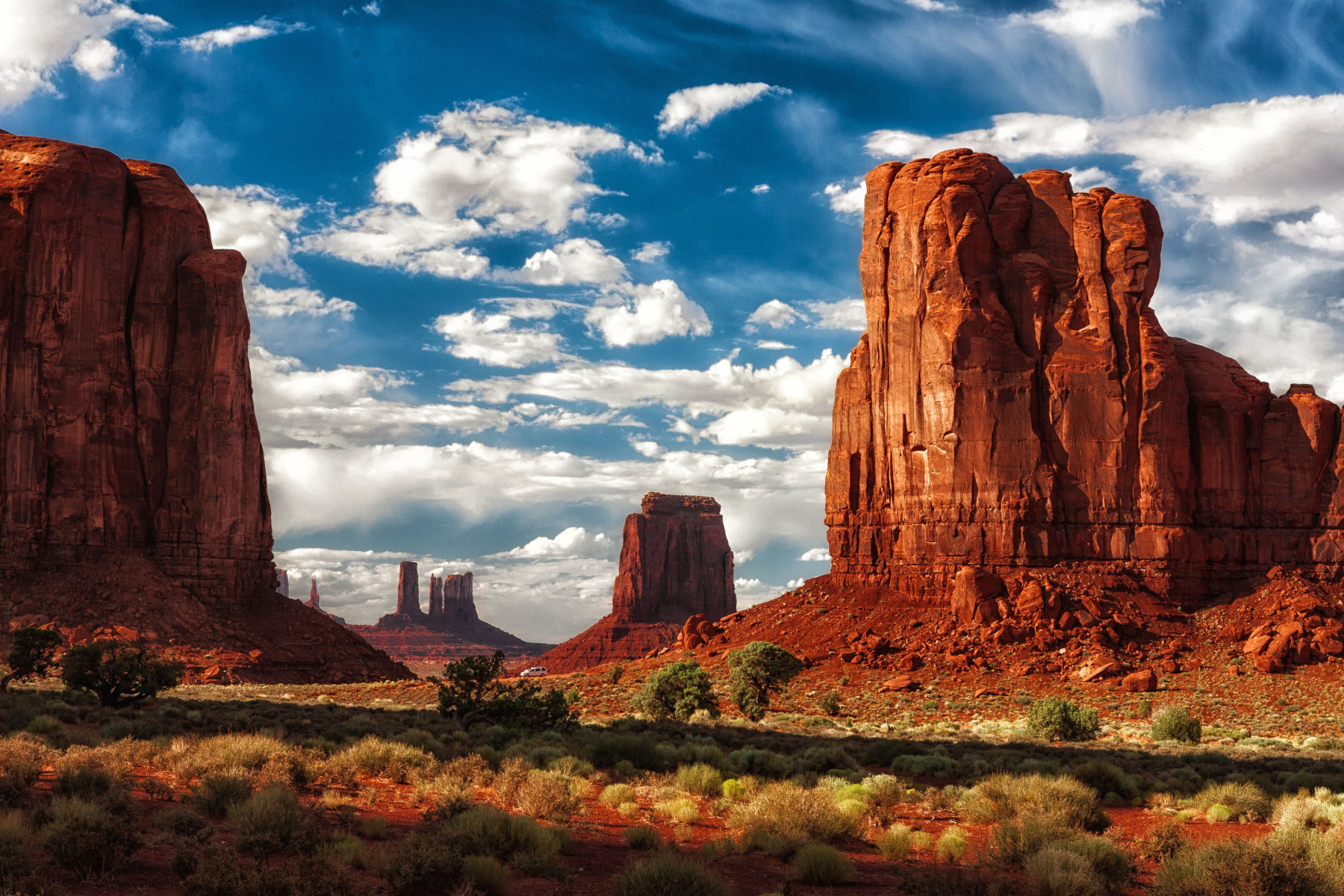
Top 20 Utah Landmarks
20. St. Mark’s Episcopal Cathedral
St. Mark’s Episcopal Cathedral is a historic church located in Salt Lake City, Utah. It was founded in 1870, just three years after Utah became a state. The church was originally known as St. Mark’s Chapel and was located in downtown Salt Lake City.
The first permanent building for St. Mark’s was constructed in 1874 on the corner of 200 East and 200 South in Salt Lake City. The building was designed by the famous Utah architect, Truman O. Angell, who was also responsible for designing many of the buildings in Salt Lake City’s Temple Square.
Over the years, St. Mark’s Cathedral has undergone several renovations and expansions. In 1907, the original wooden building was replaced with a new brick structure that included a bell tower and a chancel. In 1917, a large pipe organ was installed, which remains in use today.

St. Mark’s Cathedral & The Civil Rights Movement
During the 1960s and 1970s, St. Mark’s Cathedral was involved in the Civil Rights Movement, hosting several events and speeches by civil rights leaders such as Martin Luther King Jr. and Ralph Abernathy.
In 1994, St. Mark’s Cathedral was designated as the cathedral church of the Episcopal Diocese of Utah. This meant that it became the official seat of the bishop of the diocese.
In 2010, St. Mark’s Cathedral underwent a major renovation and expansion project. The project included the construction of a new wing that houses classrooms, offices, and meeting spaces. The project also included the installation of new stained glass windows and a new organ.
Today, St. Mark’s Cathedral remains an important religious and cultural landmark in Salt Lake City. It is known for its beautiful architecture, rich history, and vibrant community of worshippers.

19. Alkali Ridge
At #19 on our list of the Best Utah Landmarks is an archaeological site located in the southeastern corner of Utah, near the town of Bluff. Welcome to Alkali Ridge.
The site is known for its well-preserved ancient ruins and artifacts, which provide important insights into the lives and cultures of the Ancestral Puebloans who inhabited the region over a thousand years ago.
The history of Alkali Ridge dates back to around 700 AD when the Ancestral Puebloans began to build their homes and communities in the area. The site is situated near a natural spring, which would have provided a reliable source of water for drinking, farming, and other activities.
Over time, the Ancestral Puebloans built a network of homes, storage structures, and ceremonial buildings on the site, creating a thriving community that lasted for several centuries.
The Ancestral Puebloans Abandoned The Site
By the late 1200s, the Ancestral Puebloans had largely abandoned the Alkali Ridge site and other settlements in the region. It is believed that a combination of factors, including drought, resource depletion, and social conflict, contributed to the decline and eventual abandonment of the communities.
In the 1800s, European settlers began to explore and settle the region around Alkali Ridge, but it was not until the 1900s that the archaeological significance of the site was recognized.
In the 1930s and 1940s, archaeologists from the University of Utah and other institutions conducted extensive excavations at the site, uncovering a wealth of artifacts and structures that shed new light on the lives of the Ancestral Puebloans.
Today, Alkali Ridge is a protected archaeological site that is managed by the Bureau of Land Management. Visitors can explore the ruins and learn about the history and culture of the Ancestral Puebloans through interpretive exhibits and guided tours.
The site is also an important research site for archaeologists and other scholars who are interested in studying the prehistoric cultures of the American Southwest.
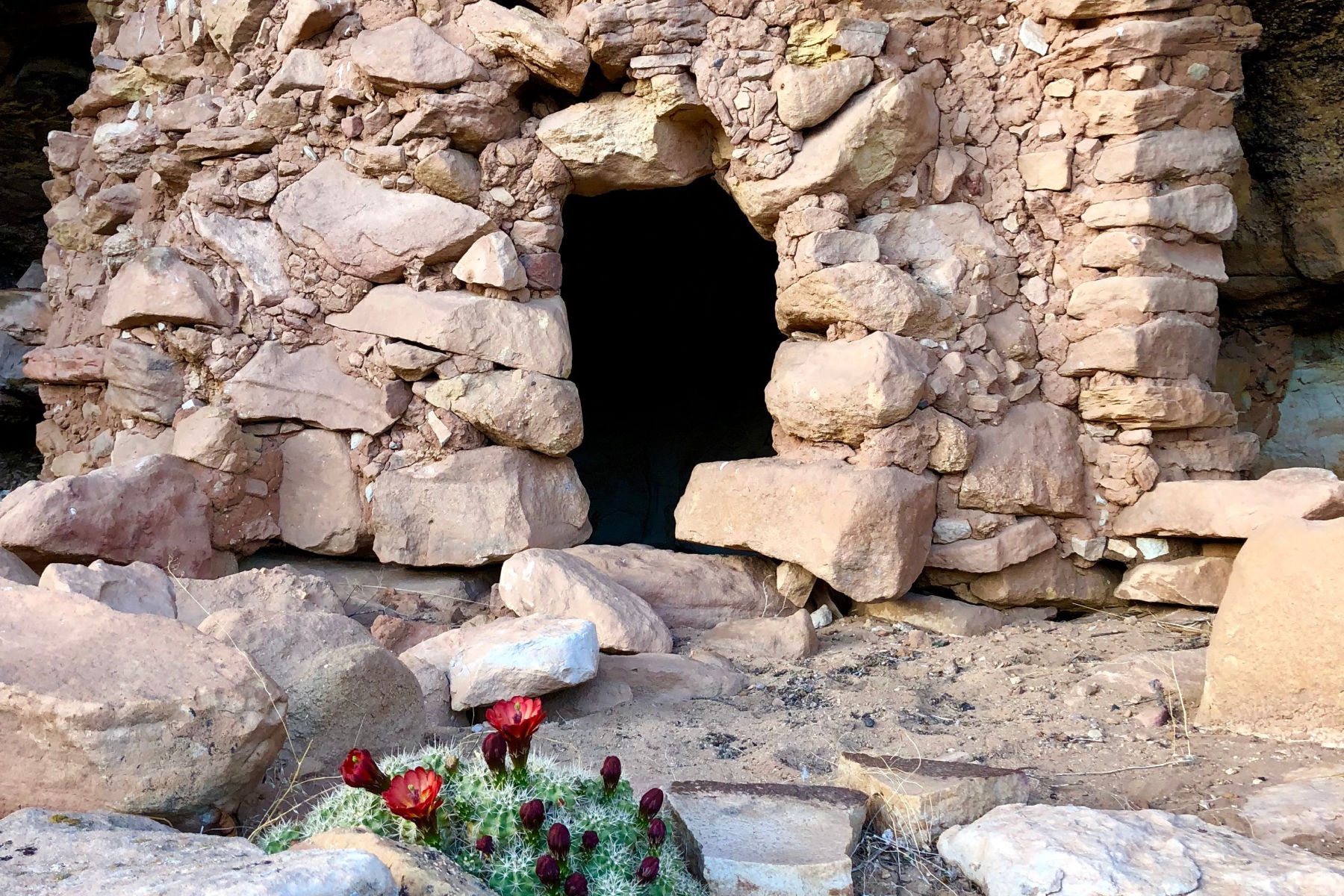
18. Historic South Temple Street
Our next Utah landmark is significant as the first stately residential boulevard in Utah and remains today, much of it still residential, as a reminder of a lifestyle that is gone.
It served as the only primary east-west route in early settlement days between the city and Red Butte Canyon, and Fort Douglas (established in 1862).
At #18 on our list of the Best Utah Landmarks is Historic South Temple Street.
Historic South Temple Street is a prominent street in Salt Lake City, Utah, known for its historic architecture and cultural significance. The street stretches from downtown Salt Lake City to the east bench of the Wasatch Mountains, passing through the city’s historic district and several prestigious neighborhoods.
Many of the buildings along South Temple Street date back to the late 19th and early 20th centuries, reflecting the city’s rich history and Mormon pioneer heritage. Some of the most notable buildings on the street include: the Salt Lake Temple, the Cathedral of the Madeleine, and the Governor’s Mansion.
In addition to its architectural and cultural attractions, South Temple Street is also known for its scenic views of the Wasatch Mountains and its proximity to outdoor recreational opportunities. The street is lined with trees and well-manicured gardens, making it a popular destination for pedestrians and cyclists.
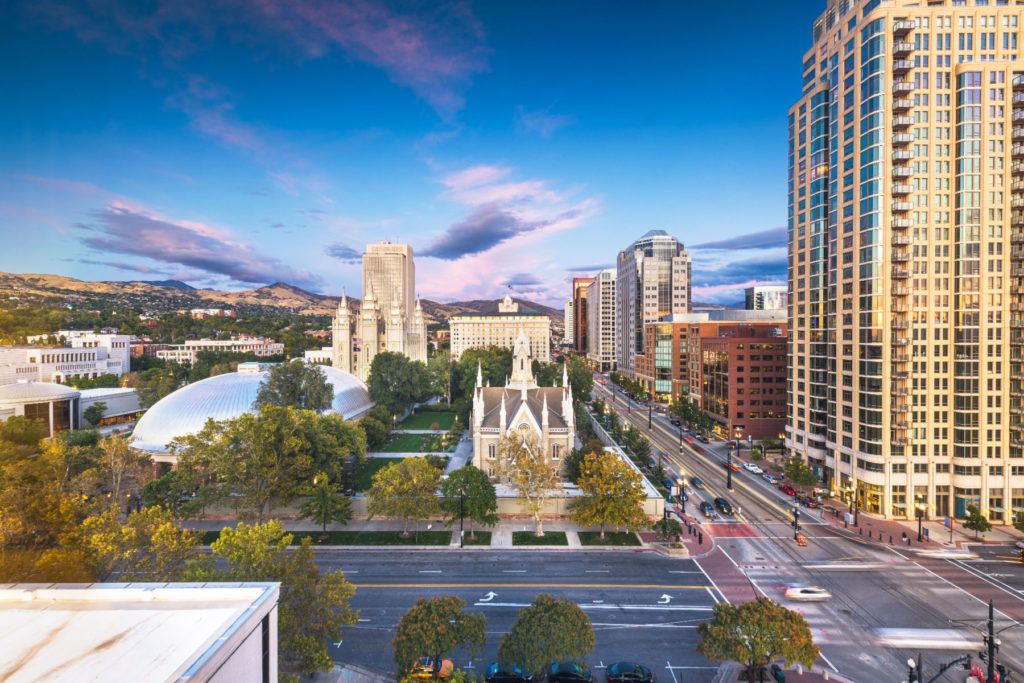
17. The Place Heritage Park
Our next Utah landmark is situated on 50 acres of land at the base of the Wasatch Mountains and features several historic buildings and exhibits that showcase the history and culture of the area. At #17 on our list of the Best Utah Landmarks is The Place Heritage Park.
The Place Heritage Park has a rich history that dates back to the 1800s. The park was originally part of the Hobble Creek Ranch, which was owned by Scottish immigrant Archibald Gardner. Gardner built several buildings on the property, including a grist mill, a sawmill, and a blacksmith shop.
In the early 1900s, the property was sold to the Jensen family, who added a dairy and a creamery to the site. In 1978, the property was purchased by the city of Springville and was transformed into a historical park.
Today, visitors to The Place Heritage Park can explore several historic buildings, including the Hobble Creek Chapel, the Springville Schoolhouse, and the Studebaker Museum. The park also features exhibits that showcase the history of agriculture in the area, as well as displays that highlight the art and culture of the community.
In addition to its historical exhibits, The Place Heritage Park is also home to several annual events, including a Fourth of July celebration, a pioneer festival, and a Christmas market.
The park is a popular destination for locals and tourists alike and provides a unique glimpse into the rich history and culture of Springville and the surrounding area.

16. Topaz War Relocation Center
Our next Utah landmark commemorates one of the darkest chapters in American history. At #16 on our list of the Best Utah Landmarks is the Topaz War Relocation Center.
The Topaz War Relocation Center was a Japanese American internment camp established during World War II by the U.S. government.
It was located in Millard County, Utah and was one of ten internment camps where Japanese Americans were forcibly relocated and detained after the bombing of Pearl Harbor. The camp was in operation from September 11, 1942, to October 31, 1945.
The internment of Japanese Americans was a result of widespread anti-Japanese sentiment during World War II. The government believed that Japanese Americans posed a security threat, and as a result, over 120,000 Japanese Americans were forcibly removed from their homes and sent to internment camps throughout the country.
At Topaz, approximately 11,000 Japanese Americans were housed in tar paper-covered barracks surrounded by barbed wire. The living conditions in the camp were harsh, with limited privacy and basic necessities like food and clothing being in short supply.

Attempting To Maintain A Sense Of Normalcy
Despite the difficult living conditions, the Japanese Americans at Topaz attempted to maintain a sense of community and normalcy by forming organizations, hosting cultural events, and participating in sports leagues. After the war ended, the internees were released from the camp and many returned to their homes on the West Coast.
The Topaz War Relocation Center is now a historical site, and its remains serve as a reminder of the injustice and discrimination faced by Japanese Americans during World War II.
The site is a symbol of the power of the US government to violate civil liberties in the name of national security, and serves as a warning to future generations against similar actions.
The legacy of the Topaz War Relocation Center continues to be felt by Japanese American communities, and it remains an important part of American history.
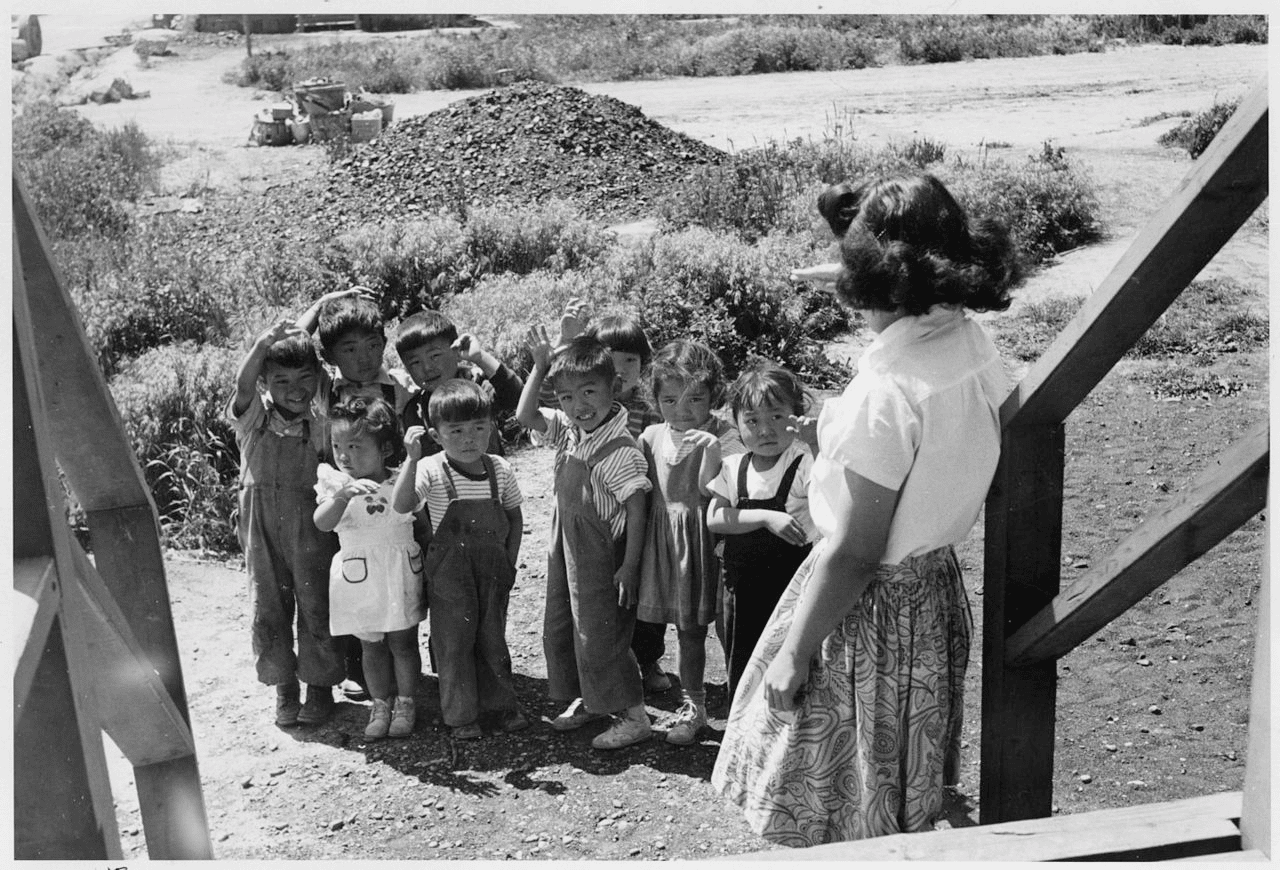
The Top 15 Utah Landmarks
15. Rainbow Bridge National Monument
We’re on to our Top 15 Utah Landmarks. At #15 is a geologic wonder. It’s considered one of the world’s longest natural bridges. Welcome to Rainbow Bridge National Monument.
The bridge spans the span of 275 feet (84 meters) and is up to 290 feet (88 meters) high.
The Rainbow Bridge is sacred to many Native American tribes, including the Navajo, Hopi, and Paiute, and has been considered a place of spiritual significance for thousands of years.
The monument was created by President William Howard Taft in 1910 and was designated a National Natural Landmark in 1963.
Visitors to the monument can take guided boat tours or hike to the bridge for views of the surrounding landscape and to appreciate the beauty and grandeur of this natural wonder.

Rainbow Bridge Has Had Some Notable Visitors
After the initial publicity, a few more adventurous souls journeyed to Rainbow Bridge. Teddy Roosevelt and author Zane Grey were among those early travelers who made the arduous trek from Oljeto or Navajo Mountain to the foot of the Rainbow.
Visiting Rainbow Bridge was made easier with the availability of surplus rubber rafts after World War II, although the trip still required several days floating the Colorado River plus a 7-mile hike up-canyon. By the early 1950s, people could travel by jet boat from Lees Ferry, then make the hike—a trip totaling three days!
What Teddy Roosevelt and his contemporaries witnessed—evidence of the significance of Rainbow Bridge to early and present day Native American cultures—is difficult to discern today.
Since then, much archeological evidence has been lost as Lake Powell, along with thousands of visitors, arrived. The Glen Canyon Dam was authorized in 1956.
By 1963, the gates on the dam closed and rising Lake Powell began to engulf the river and its side canyons. Higher water made access to Rainbow Bridge much easier, bringing thousands of visitors each year. (Source: NPS)

14. The Beehive House
Our next landmark is a historic building located in Salt Lake City, Utah. It was built in 1854 and served as the official residence of Brigham Young, the second president of The Church of Jesus Christ of Latter-day Saints (LDS Church) and the first governor of the Utah Territory.
At # 14 on our list of the Best Utah Landmarks is The Beehive House.
The history of the Beehive House is closely tied to the history of the LDS Church and its early leaders. Brigham Young played a crucial role in the settlement and development of Utah in the mid-1800s, and the Beehive House served as his home and center of operations for many years.
The house was designed in the Gothic Revival style and features a distinctive beehive-shaped structure on the roof, which is a symbol of industry and thrift in Mormon culture. The house originally had 20 rooms, including a large dining room, reception room, and private living quarters for the Young family.

The Beehive Was Used For Official Government Business
During Brigham Young’s tenure as governor, the Beehive House was also used for official government business. Young hosted many dignitaries and politicians at the house, including President James Buchanan, who visited Utah in 1858 in an attempt to resolve tensions between the federal government and the Mormon settlers.
After Brigham Young’s death in 1877, the Beehive House remained in the possession of the Young family for several decades. In 1911, the LDS Church purchased the house and began to use it as a museum and historic site. Today, the Beehive House is open to the public and offers guided tours, exhibits, and educational programs.
The Beehive House is an important symbol of Utah’s pioneer heritage and the early history of the LDS Church. It serves as a reminder of the struggles and achievements of the early settlers of Utah and the important role that Brigham Young and other Mormon leaders played in the development of the state and its institutions.

13. Bonneville Salt Flats
At #13 on our list of the Best Utah Landmarks is a geologic wonder. It’s the Bonneville Salt Flats.
The Bonneville Salt Flats is a vast salt flat located in northwestern Utah, about 120 miles west of Salt Lake City. The history of the Bonneville Salt Flats dates back millions of years, when the region was covered by a large, shallow lake known as Lake Bonneville.
Over time, the lake began to recede, leaving behind a vast expanse of salt flats and other mineral deposits. The salt flats cover an area of approximately 30,000 acres and are made up of several layers of salt and other minerals, including gypsum, potash, and magnesium.
The Bonneville Salt Flats have long been an important site for scientific research and exploration. In the late 1800s and early 1900s, several expeditions were mounted to explore the region and study its unique geology and ecology.
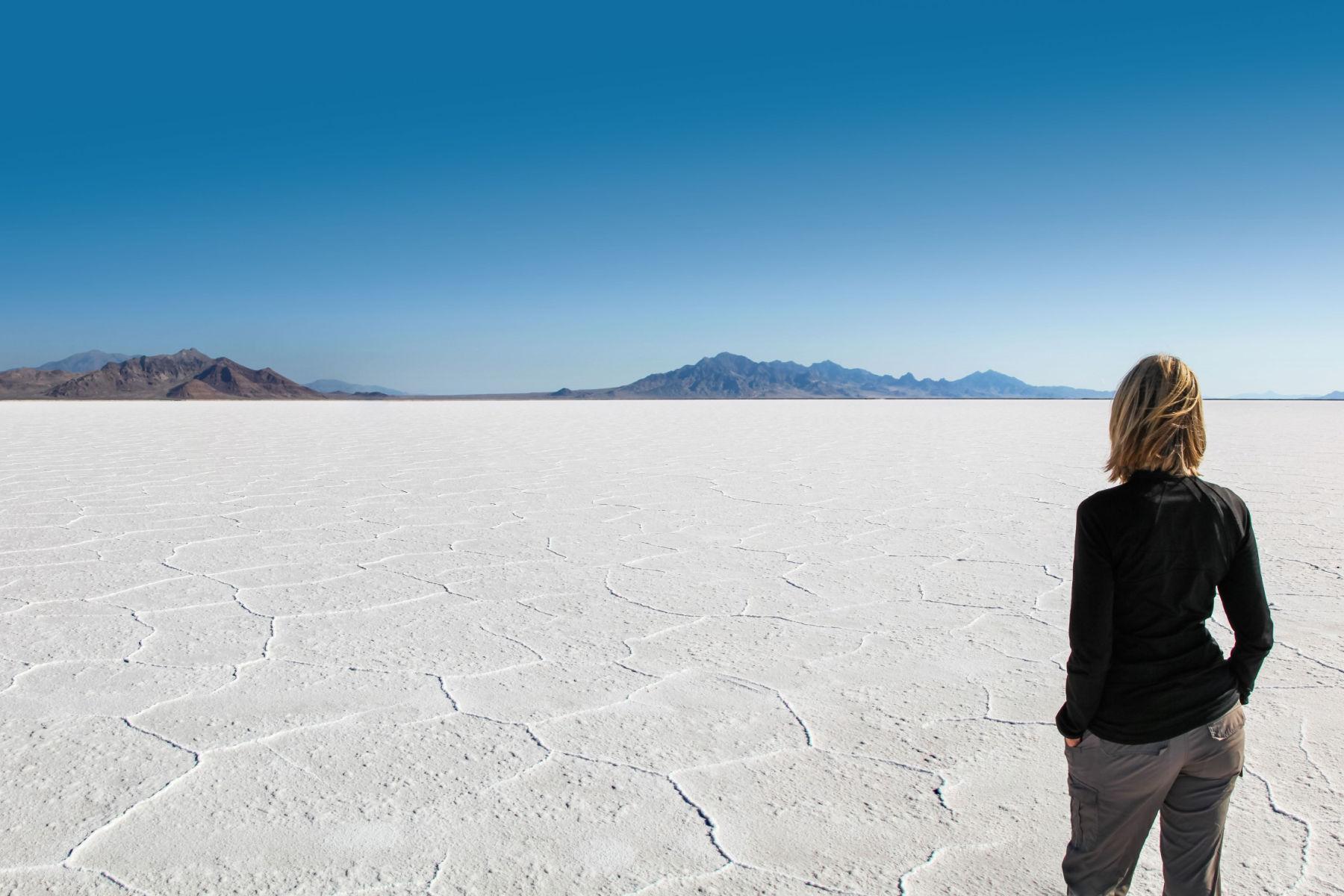
The Site Began To Attract Attention From Speed Enthusiasts
Back in the 1920s, the Bonneville Salt Flats began to attract attention from speed enthusiasts who were drawn to the flat, straight stretches of salt for land speed racing. In 1935, the first Bonneville Speed Week was held, and since then, the salt flats have become a popular site for speed racing events and other motorsports.
In addition to land speed racing, the Bonneville Salt Flats have also been used as a filming location for movies and commercials, and as a site for testing new vehicles and equipment.
Despite its importance as a natural and cultural resource, the Bonneville Salt Flats have faced challenges in recent years, including concerns over the impact of salt mining and other industrial activities on the fragile ecosystem of the region. Efforts are currently underway to protect and preserve the salt flats for future generations.
12. Jurassic National Monument
You don’t have to be a fan of the Jurassic Park film series to enjoy our next historic site. At #12 on our list of the Best Utah Landmarks is Jurassic National Monument.
According to the Bureau of Land Management, Cleveland-Lloyd Dinosaur Quarry (CLDQ) at Jurassic National Monument contains the densest concentration of Jurassic-aged dinosaur bones ever found.
Over 12,000 bones (belonging to at least 74 individual dinosaurs) have been excavated at the quarry.
Cleveland-Lloyd Dinosaur Quarry has helped paleontologists learn a great deal about the Jurassic period, yet the site presents at least as many mysteries as it helps to solve.
Curiously, more than 75% of the bones come from carnivores, primarily Allosaurus fragilis. With more than 46 individual specimens of Allosaurus, scientists have been able to deduce much about how Allosaurus aged and compare individuals to better understand intraspecies diversity.
As a visitor to this amazing place, not only do you get to see the area where the dinosaurs roamed, but you also have the opportunity to take in a “wall of bones” and even touch a dinosaur bone that dates back millions of years.

11. Natural History Museum Of Utah
At our next Utah landmark, you can experience fascinating artifacts, jaw-dropping dinosaurs, amazing science and breathtaking views of the Salt Lake Valley.
At #11 on our list of the Best Utah Landmarks is the Natural History Museum of Utah.
The Natural History Museum of Utah is a museum located on the campus of the University of Utah in Salt Lake City, Utah. The museum was founded in 1963 and moved to its current location in 2011.
The museum’s mission is to inspire curiosity and understanding of the natural world through exhibits, educational programs, and research. The museum houses a collection of over 1.5 million objects, including fossils, minerals, plants, and animals.
The exhibits at the museum cover a wide range of topics, including Utah’s geology, ecology, and biodiversity, as well as the history of the state’s indigenous peoples.
Some of the highlights of the museum include a full-size replica of a Tyrannosaurus Rex, a display on Utah’s dinosaurs, a hands-on exhibit on the Great Salt Lake, and a gallery showcasing the art and science of natural history.
The museum also offers a variety of educational programs for visitors of all ages, including field trips, summer camps, and lectures. Additionally, the museum has a research department that studies the natural world and contributes to scientific knowledge.

Natural History Museum Of Utah | Courtesy of Wikimedia Commons
Top 10 Utah Landmarks
10. Natural Bridges National Monument
We’re on to our Top 10 Utah landmarks. At #10 on our list is Natural Bridges National Monument.
Did you know that people repeatedly occupied and abandoned Natural Bridges during prehistoric times?
They first began using this area during the Archaic Period, from the year 7000 BCE (Before Common Era) to 500 CE (Common Era).
Only the rock art and stone tools left by hunter-gatherer groups reveal that humans lived here then.
According to the National Park Service, three hundred years after their ancestors left, the farmers returned. They built homes of sandstone masonry or mud-packed sticks, both on the mesa tops and in alcoves in the cliffs.
South facing caves provided passive solar heating and cooling. The farmers often chose sites near seep springs where water could be found.

Utah’s First National Monument
Natural Bridges National Monument is Utah’s first national monument and visitors to this incredible place will discover three majestic natural bridges.
Declared a National Monument in 1908, the bridges are named “Kachina,” “Owachomo” and “Sipapu” in honor of the ancestral Puebloans who once made this place their home.
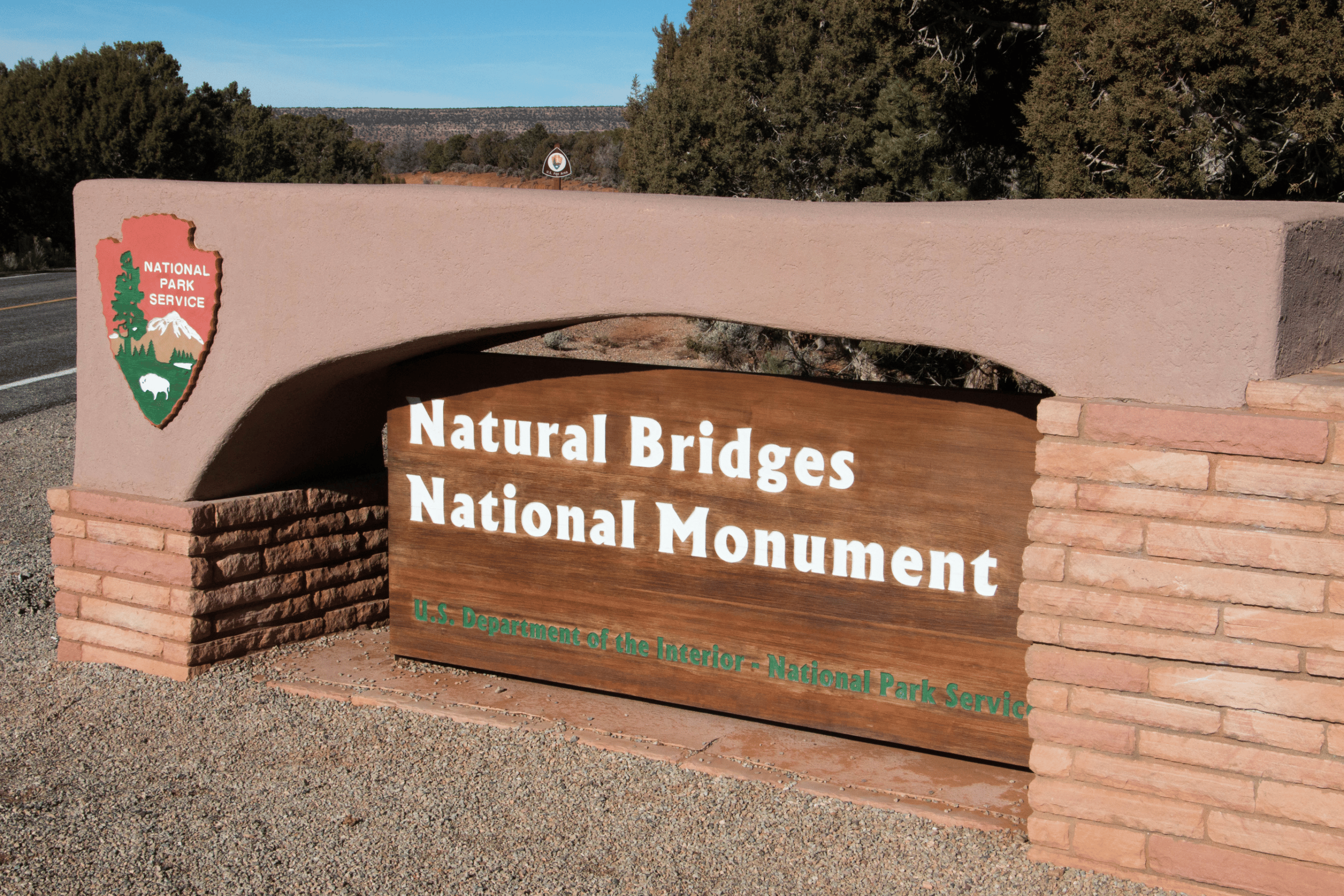
Hiking At Natural Bridges
Among the incredible hiking trails at Natural Bridges are the following:
- The Full Loop which is 12-miles (19.3 kilometers) and passes all three natural bridges as it winds through the canyons and over the mesa top. This trail is primitive and strenuous. Pets are not allowed on this trail (service animals are). Stop at the visitor center for updated conditions and detailed directions.
- The Sipapu-Kachina Loop which is 5.7 miles (9.2 kilometers) and passes by Sipapu and Kachina Bridges, through canyons, and over the mesa top. This trail is primitive and strenuous. Pets are not allowed on this trail (service animals are). Stop at the visitor center for updated conditions and detailed directions.
- Kachina-Owachomo Loop which is 6.5 miles (10.5 kilometers) and passed by Kachina and Owachomo Bridges, through canyons, and over the mesa top. This trail is primitive and strenuous. Pets are not allowed on this trail (service animals are). Stop at the visitor center for updated conditions and directions. (Source: NPS)
Camping is available and campsites are first-come, first-served and open year-round. Each site has a fire grill, picnic table, and tent pad, but no running water, electricity, or hookups.

9. Parowan Gap Petroglyphs
What’s so wonderful about our Utah Landmarks is that so many feature a history of long, long ago. At #9 on our list of the Best Utah Landmarks is just such a place. Welcome to Parowan Gap Petroglyphs.
Now you might be someone who enjoys Revolutionary War or Civil War historic sites, but, in the case of this our next site, you can connect with a past which reaches back to the days of the dinosaurs.

Geologic History Of Parowan Gap
Approximately 15 million years ago, a long slender section of sedimentary rock sheared from the earth’s crust along parallel fault lines. This up-thrown block, later named the Red Hills, began to inch its way above the surrounding valley floor.
At the same time the block was rising, a stream was cutting a path perpendicularly across the ridge. For millions of years the uplifting of the ridge and the down-cutting of the stream remained in equilibrium.
The petroglyphs here are thought to be the work of several cultural groups and represent a long period of use by Native cultures. What these designs mean is still unknown.
Archaeologists debate that they represent concepts, ideas or actual happenings. Perhaps they were part of a religious activity or hunting ritual.
As for the local Native Americans, they consider them to be an important part of their cultural history relating stories of their ancestor’s lifeways.
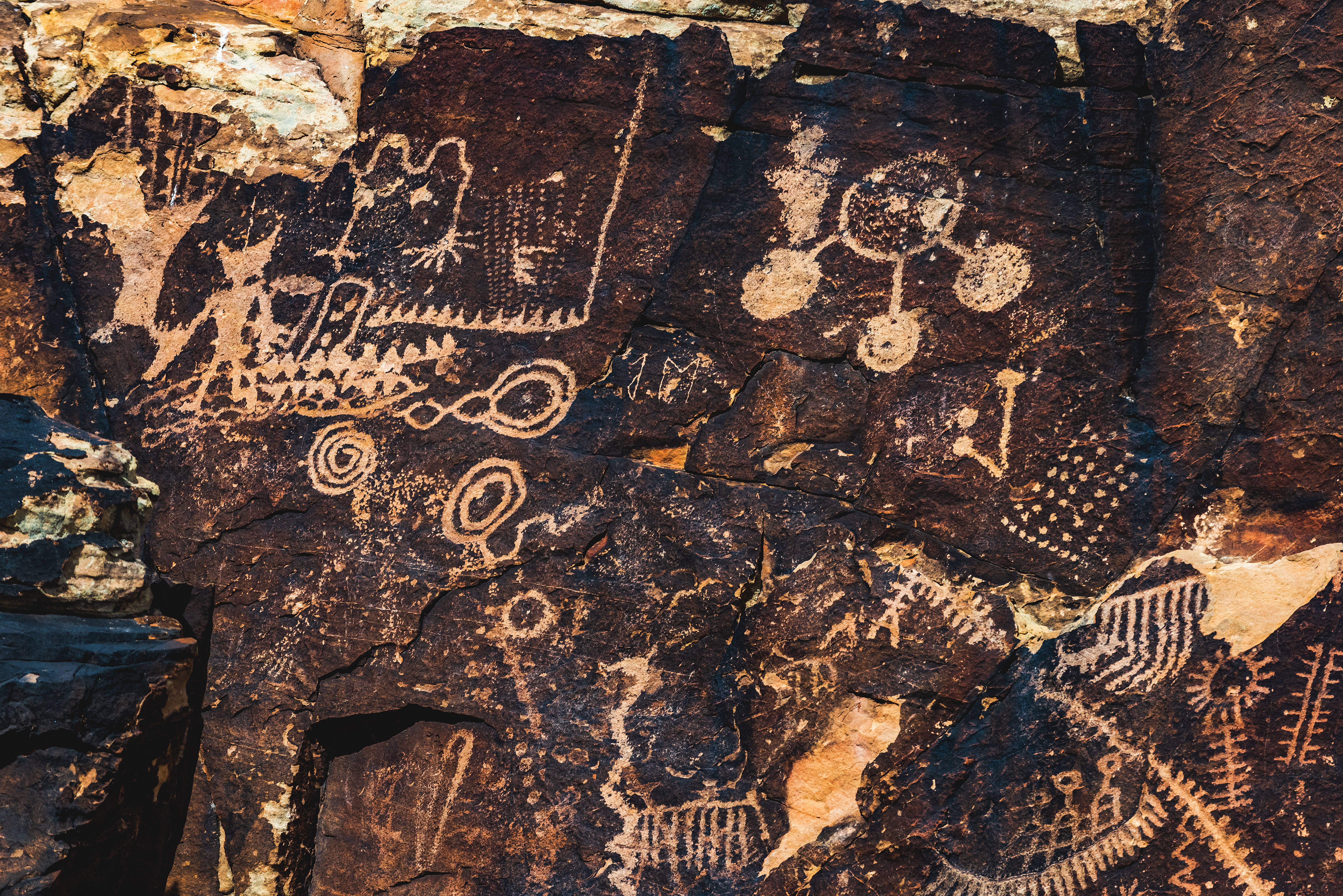
A Superb Gallery Of Native American Rock Art
Parowan Gap is a nationally recognized extravaganza of petroglyphs–a superb “gallery” of Native American rock art. Here one can witness what is at least a 1,000 year accumulation of artwork pecked into the rock.
Geometric designs, images of lizards, snakes, mountain sheep, bear claws and human figures adorn the smooth canyon walls of the pass.
While we don’t know the precise age of these petroglyphs yet, we do know that the agriculturally based Sevier-Fremont lived in the area over a thousand years ago.
There is little doubt that some of the designs were made by this group, or perhaps even the earlier nomadic Archaic peoples.
Researchers believe that the semi-nomadic ancestors of the present day Southern Paiute also created some of these figures. (Source: Utah.com)
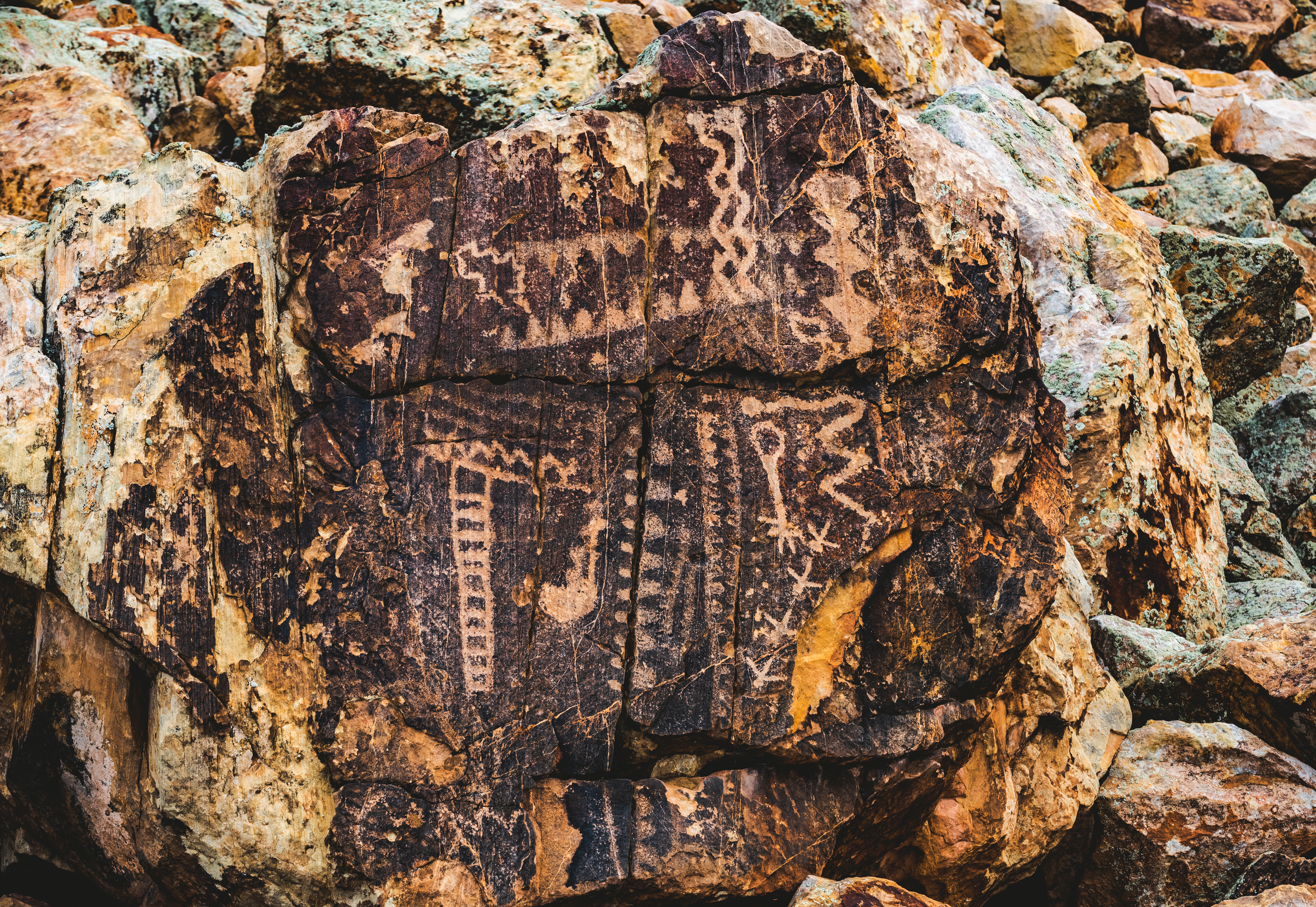
8. Dinosaur National Monument
Our next Utah landmark was originally preserved in 1915 to protect its famous Dinosaur Quarry. The park’s wild landscapes, topography, geology, paleontology, and history make it a unique resource for both science and recreation.
At #8 on our list of the Best Utah Landmarks is Dinosaur National Monument.
Dinosaur National Monument is a hidden gem straddling the remote northern corners of two states, Colorado and Utah.
The common refrain here is that if you’re interested in dinosaurs you’ll love this monument – which is true, but it vastly undersells this sprawling and immensely beautiful monument.
In addition to the famous dinosaur quarry and countless immaculately preserved dinosaur bones and skulls from various species, the park is home to over 200,000 acres of outdoor grandeur.
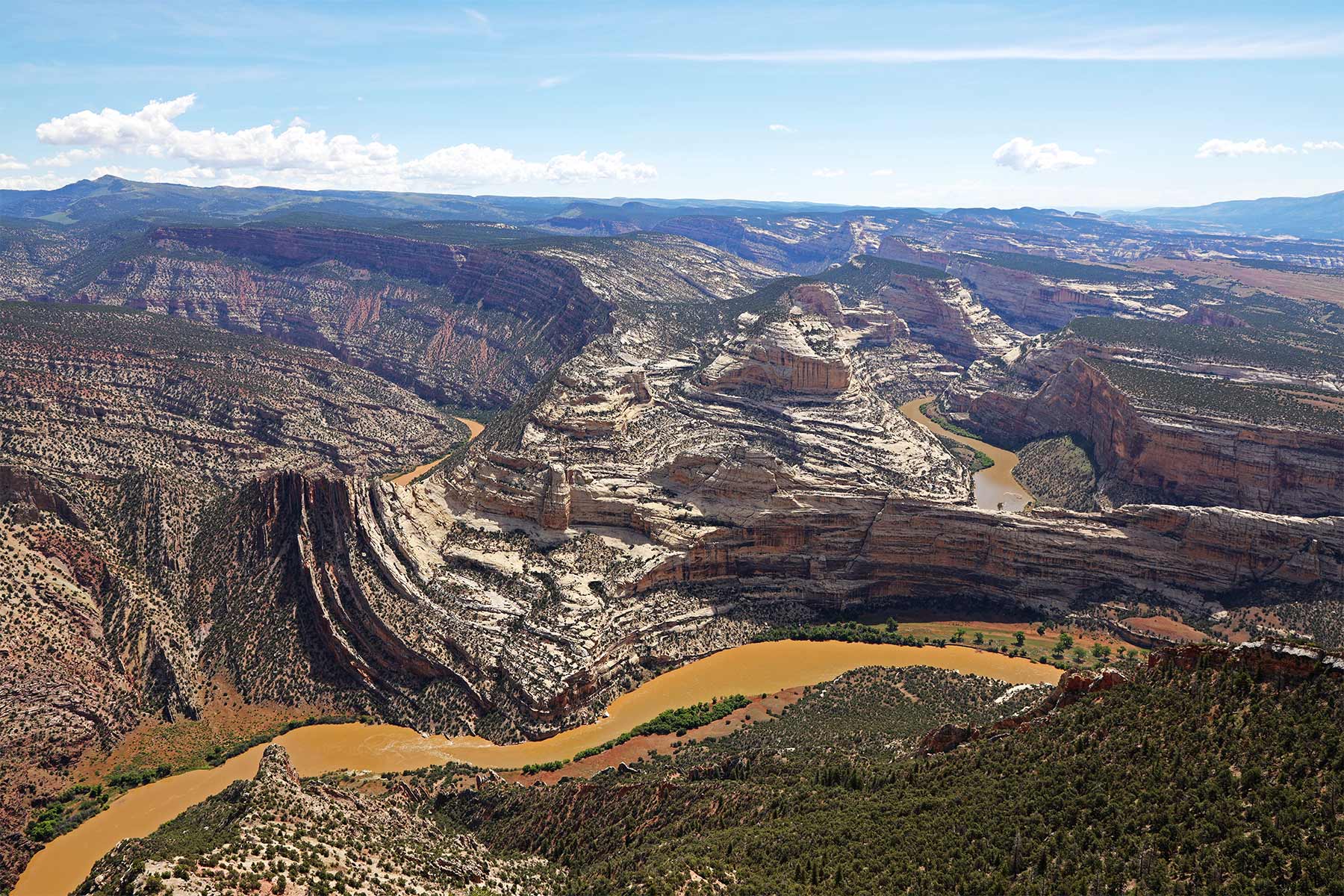
There’s So Much To See
Here you can peer into the depths of stunning red rock canyons, whitewater raft the world-class Green or Yampa rivers, explore historic cabins and ponder ancient petroglyphs, camp out under a star-studded sky, and of course hike numerous trails venturing into the rugged and beautiful surroundings.
And while you’re there be sure to check out the Quarry Exhibit Hall which allows visitors to view the wall of approximately 1,500 dinosaur bones in a refurbished, comfortable space.
Here, you can gaze upon the remains of numerous different species of dinosaurs from the Late Jurassic period, including Allosaurus, Apatosaurus, Camarasaurus, Diplodocus, and Stegosaurus along with several others.

7. Golden Spike National Historic Site
Our next landmark commemorates the completion of the first transcontinental railroad in the United States. At #7 on our list of the Best Utah Landmarks is the Golden Spike National Historic Site.
The Golden Spike National Historic Site is located in Promontory, Utah.
The history of the site is closely tied to the construction of the railroad in the mid-1800s and the important role it played in the development of the American West.
In the early 1860s, the Central Pacific Railroad Company began construction of a railroad line eastward from Sacramento, California, while the Union Pacific Railroad Company began building a line westward from Omaha, Nebraska.
The two lines eventually met at Promontory, Utah, on May 10, 1869, where a golden spike was driven into the ground to mark the completion of the transcontinental railroad.
The ceremony at Promontory was a major event in American history, and thousands of people gathered to witness the occasion.
The golden spike, which was made of 17.6 karat gold, was donated by David Hewes, a California businessman, and was engraved with the words “May God continue the unity of our Country, as this Railroad unites the two great Oceans of the world.”
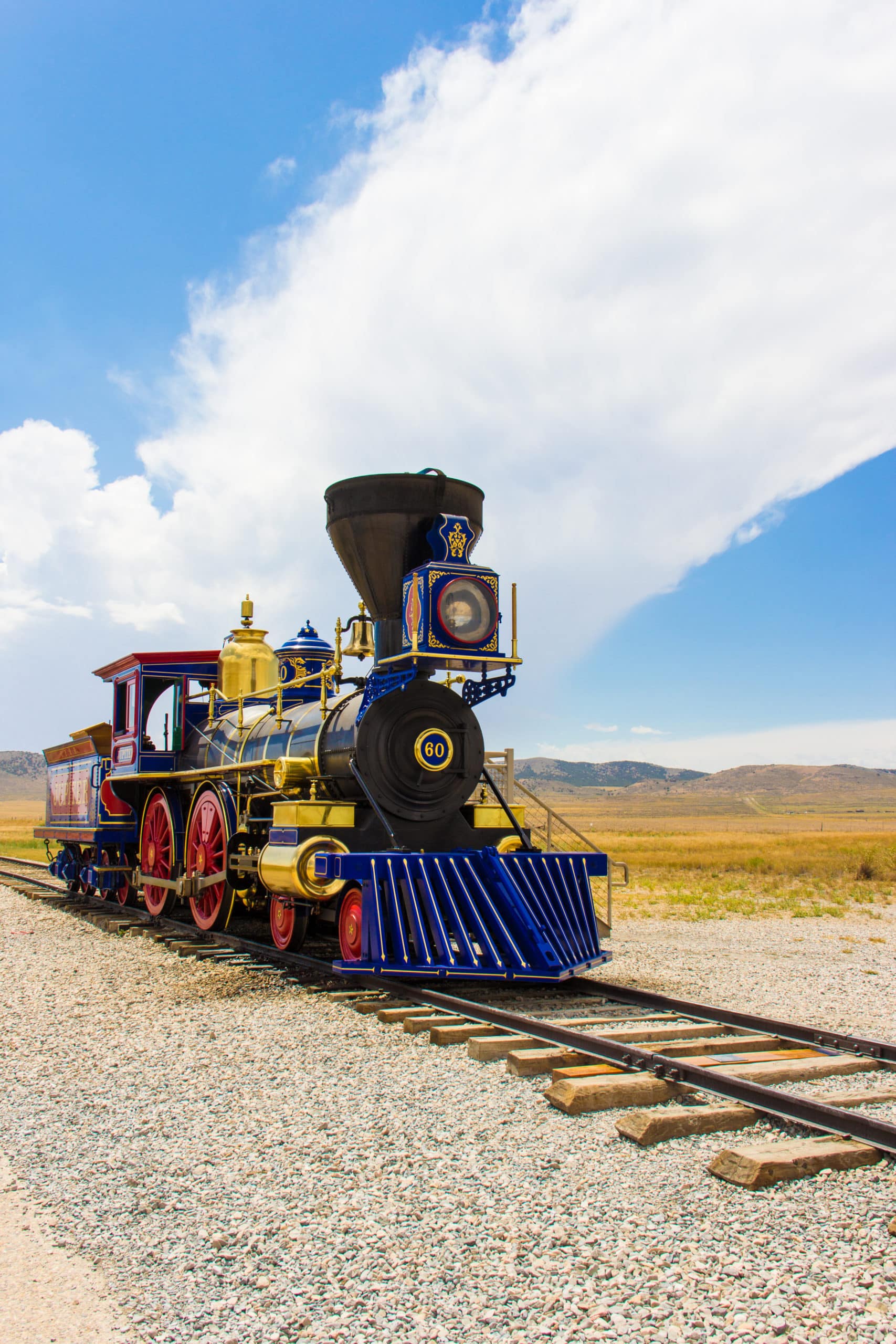
After The Completion Of The Railroad
After the completion of the transcontinental railroad, Promontory remained an important transportation hub for several decades, serving as a major junction for rail traffic and a center of commerce and industry in the region. However, with the decline of the railroad industry in the mid-20th century, the site fell into disuse and was eventually abandoned.
In 1957, the Golden Spike National Historic Site was established to commemorate the completion of the transcontinental railroad and to preserve the historic site for future generations.
The site includes a replica of the original golden spike, as well as several historic locomotives and other artifacts related to the construction of the railroad.
Today, the Golden Spike National Historic Site is a popular destination for tourists and railroad enthusiasts, who come to learn about the history of the transcontinental railroad and to witness reenactments of the driving of the golden spike. The site is open year-round and offers a variety of educational programs, exhibits, and special events.
To learn more about this fascinating chapter in American history, I recommend Nothing Like It In the World: The Men Who Built the Transcontinental Railroad 1863-1869 by Stephen Ambrose.

Golden Spike National Historic Site | Photo Courtesy of NPS
6. Bears Ears National Monument
Our next Utah landmark’s rich cultural heritage is held sacred by many Native American Tribes, who continue to rely on these lands for traditional and ceremonial uses.
At #6 on our list of the Best Utah Landmarks is Bears Ears National Monument.
As one of the many premier outdoor destinations in the state of Utah, Bears Ears National Monument should be on the bucket lists of every public lands enthusiast.
It protects some of the most beautiful and unique lands in the southwest including both natural and cultural wonders.
Every year, visitors to the Bears Ears region enjoy many recreation activities, including hiking, backpacking, rock climbing, river rafting, and riding off highway vehicles.

The Battle To Preserve Bears Ears
The Bears Ears Cultural Landscape in Southeast Utah includes archaeological sites, cliff dwellings, petroglyphs, and ancient roads that tell stories of diverse people over the course of 12,000 years.
After years of collaboration between the Bears Ears Intertribal Coalition and others, along with the public comment process, President Barack Obama named Bears Ears a national monument on December 28, 2016, and protected 1.35 million acres of land for one of the most significant cultural landscapes in our history.

Trump Threatens The Monument
On December 4, 2017, President Donald Trump announced his decision to revoke Bears Ears National Monument in southeastern Utah and replace it with two much smaller monuments.
This action removed protections from more than a million acres that include thousands of extraordinary archaeological sites vulnerable to looting and vandalism.
Joe Biden To The Rescue
On October 8, 2021, President Joe Biden issued a proclamation restoring Bears Ears National Monument in southeast Utah.
With this action, full protections are back in place for Bears Ears, an area rich with archaeological resources, prehistoric cliff dwellings, paleontological resources, and sites sacred to many Native American tribes. (Source: National Trust For Historic Preservation)
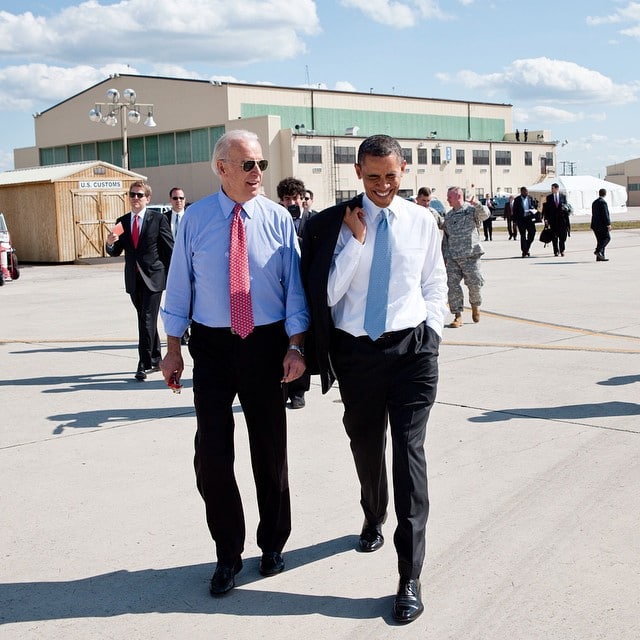
Three Main Areas To Visit In Bears Ears
There are three main areas on BLM-managed lands where you may consider recreating within Bears Ears National Monument:
- Indian Creek: It’s a scenic corridor along Highway 211 where visitors can enjoy a number of recreational activities. Climbers flock to this area in the spring and fall to test their skills on some of the best crack climbing routes in the country. Bird watchers keep their eyes peeled for raptors like Golden Eagles and Peregrine Falcons, which make their homes on Indian Creek’s sheer, dramatic cliffs.
- Cedar Mesa & Comb Ridge: They are large landforms located in the southern portion of Bears Ears National Monument. These areas contain many cultural resources, which draw the attention and admiration of many recreationists. Backpackers and day hikers alike enjoy rugged routes through the deep gorges of Grand Gulch and the many canyons within Comb Ridge.
- San Juan River: It winds through some of the most spectacular views in canyon country, abound with natural and cultural resources. Boaters enjoy the San Juan River by raft, kayak, stand-up paddleboard, or packraft! A permit is required to float on the San Juan River year-round, including permits issued by lottery for launch dates from April 15th through July 15th. (Source: BLM)
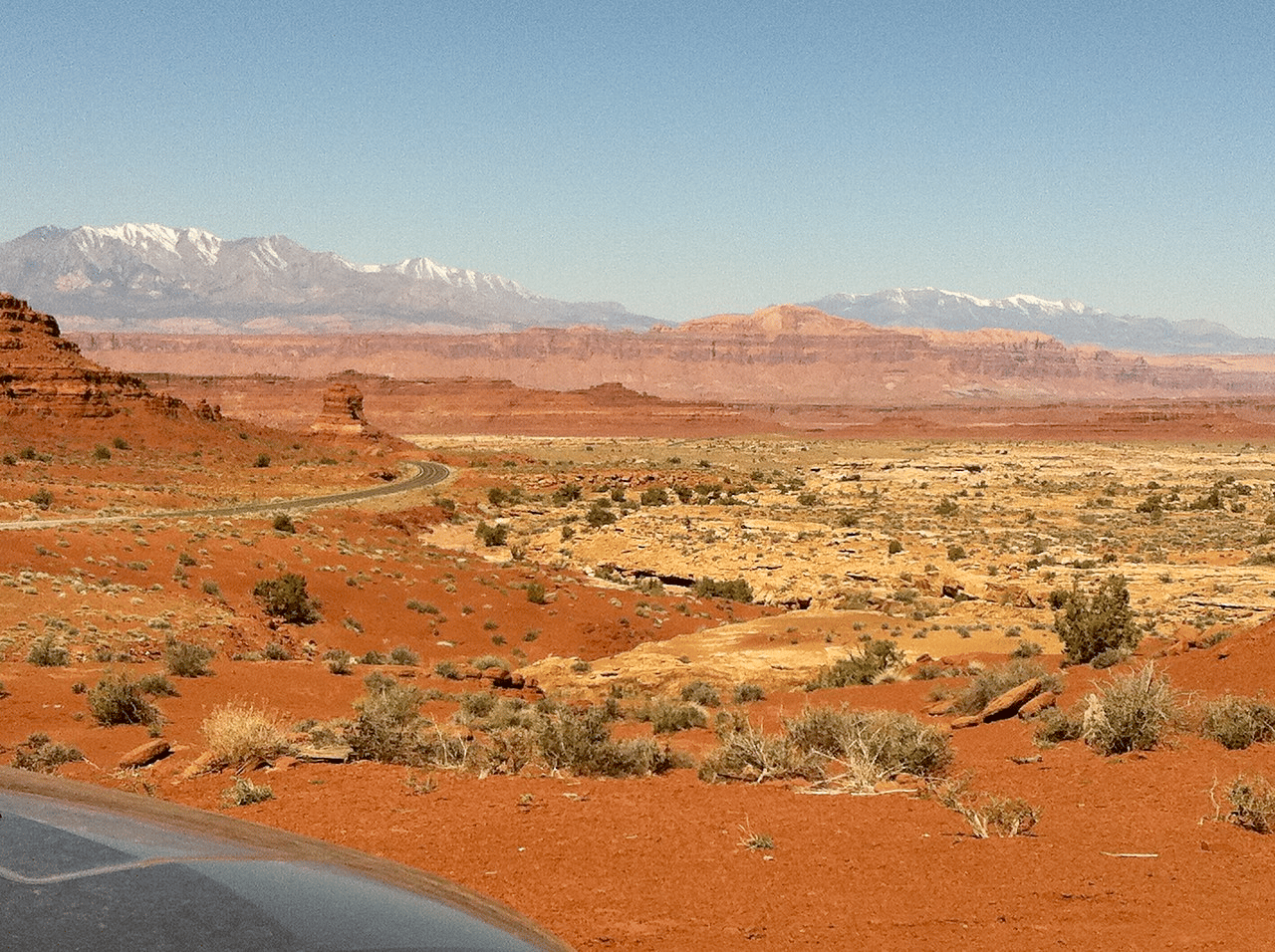
Top 5 Utah Landmarks
5. Capitol Reef National Park
We’re on to our Top 5 Utah Landmarks. At #5 is one of Utah’s Might Five National Parks. It’s Capitol Reef National Park.
Probably the least known Utah national park, and yet it’s easily one of the best.
No crowds, abundant scenery, and there’s even a small town (Torrey) nestled up against the park that has restaurants and conveniences that will surprise you.
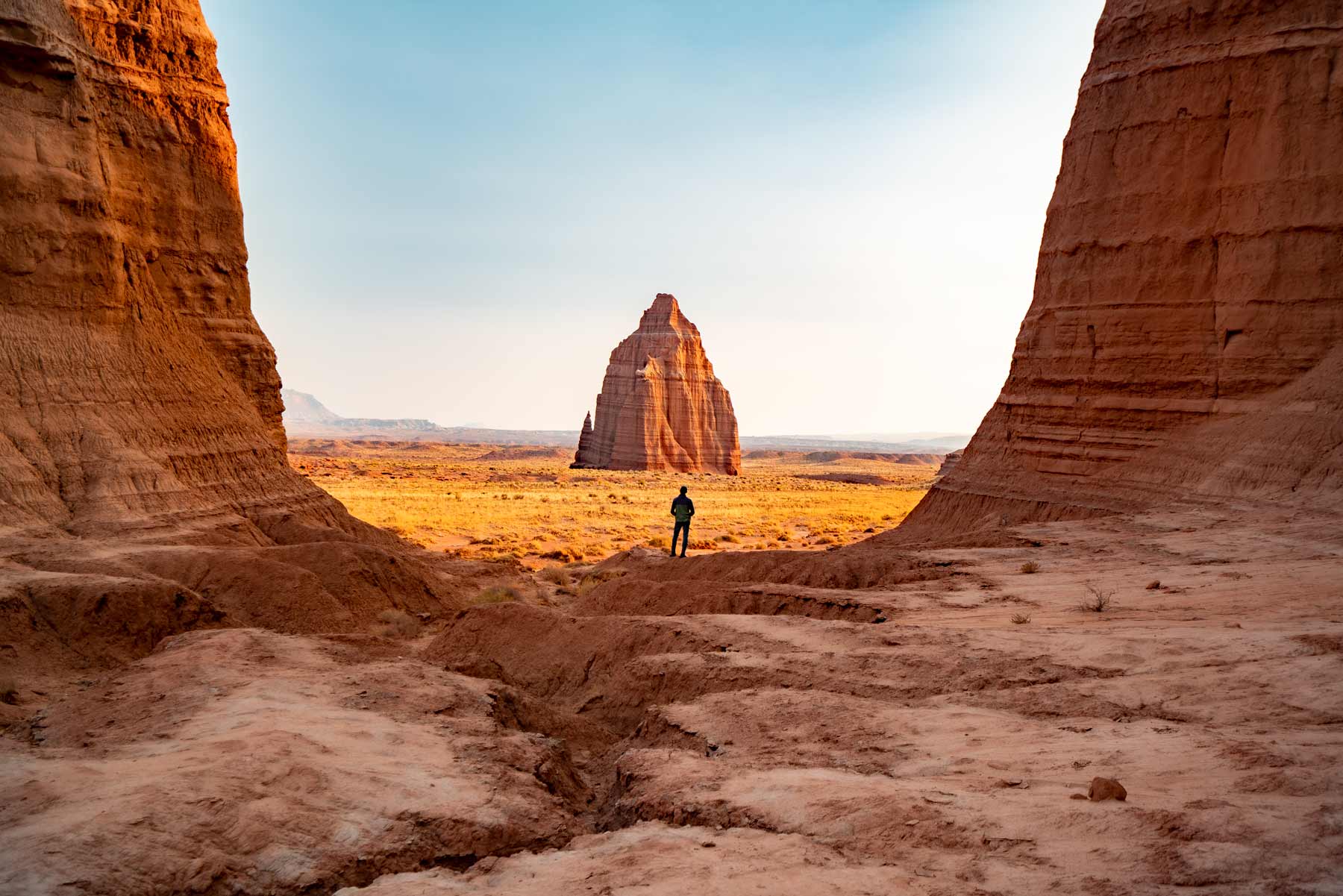
Lots of great day-hikes and truly out of this world stargazing opportunities (pun intended).
Overlooks that look out on vast and lonely landscapes shaped by geological activity over millennia, uncrowded trails through ancient petroglyphs, natural arches, and beautiful red rock scenery, and historic structures preserving early pioneer life.
What’s not to like about this often-overlooked Utah gem?
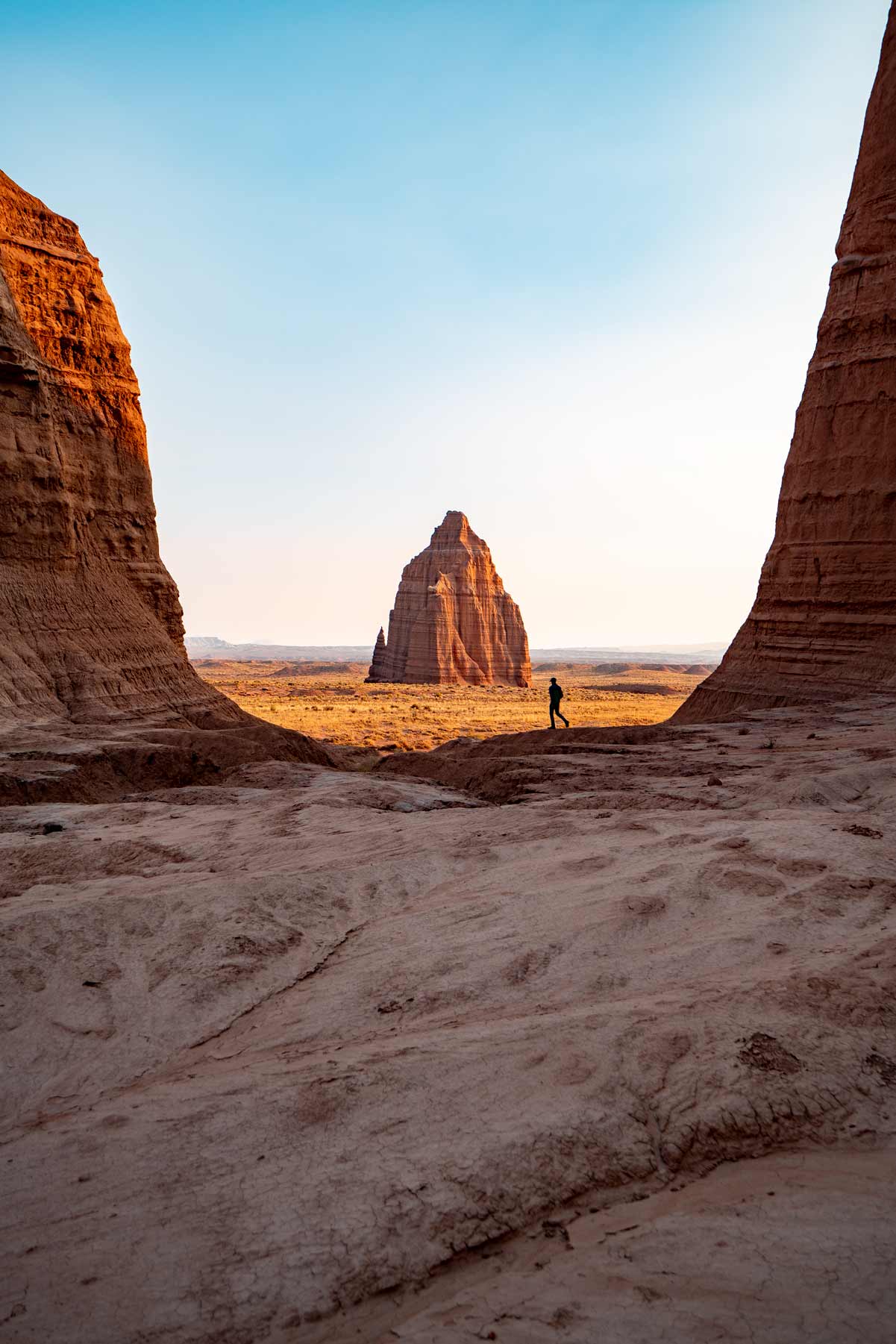
Things To Do At Capitol Reef
Capitol Reef National Park is a beautiful destination for nature enthusiasts, hikers, and history buffs. Here are some things you can do during your visit:
- Hiking: Capitol Reef National Park offers a variety of hiking trails for all skill levels. The most popular hikes are the Capitol Gorge Trail, the Hickman Bridge Trail, and the Grand Wash Trail.
- Scenic Drives: Take a scenic drive along the Capitol Reef Scenic Drive, which winds through the park and offers stunning views of the red rock formations.
- Camping: There are several campgrounds in the park, including Fruita Campground, which is located in an orchard with apple, peach, pear, and apricot trees.
- Historical Sites: Visit the Fruita Rural Historic District, which is home to a number of historic buildings, including a blacksmith shop, a schoolhouse, and a pioneer cabin.
- Stargazing: Capitol Reef National Park is a designated dark sky park, which means that there is minimal light pollution and the night sky is incredibly clear.
- Horseback Riding: Guided horseback rides are available from the park’s concessionaire.
- Rock Climbing: The park has several popular rock climbing areas, including the Chimney Rock area and the South Draw.
- Ranger Programs: The park offers a variety of ranger-led programs, including guided hikes, talks, and evening programs.
- Photography: The stunning red rock formations and dramatic landscapes of Capitol Reef National Park make it a photographer’s dream.
- Wildlife Watching: Keep your eyes peeled for bighorn sheep, mule deer, coyotes, and other wildlife that call the park home.
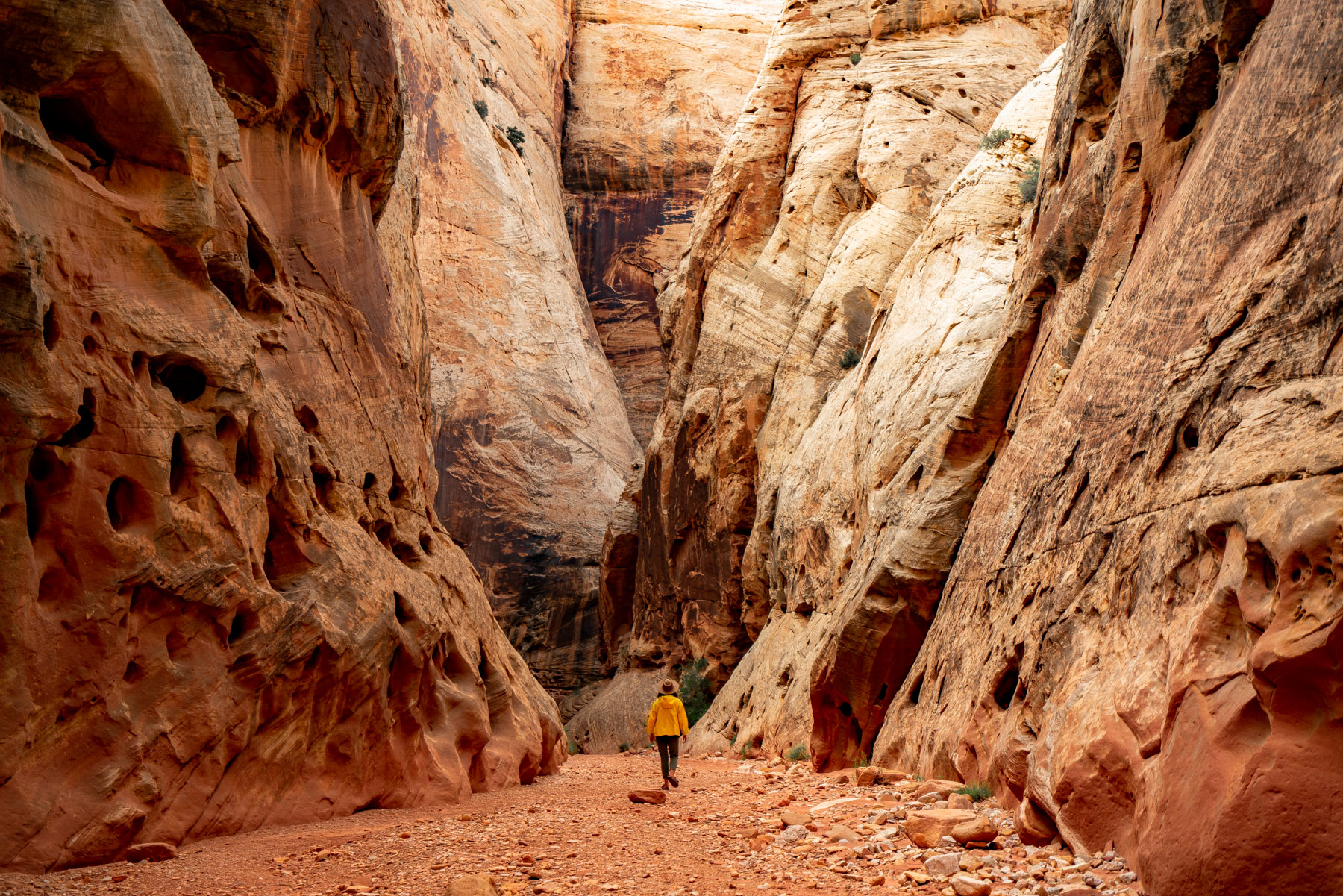
4. Monument Valley
We’re on to our final 4 Utah landmarks. At #4 is a magical place that is host to towering sandstone rock formations that have been sculpted over time and soar 400 to 1,000 feet above the valley floor.
Combined with the surrounding mesas, buttes, and desert environment, it truly is one of the natural wonders of the world. Welcome to Monument Valley.
Monument Valley is a region of the Colorado Plateau characterized by a unique and stunning landscape of towering sandstone formations and mesas, located on the border of Arizona and Utah in the southwestern United States.
The valley is known for its iconic red rock formations that rise up to 1,000 feet (305 meters) above the surrounding terrain. The area is sacred to the Navajo people and has been used as a filming location for many Western movies.

It’s Located Within The Navajo National Reservation
Monument Valley is located within the Navajo Nation Reservation, and visitors can only access the area with a Navajo guide or by paying an entrance fee to the tribal park. The park offers guided tours by local Navajo guides in traditional vehicles, such as open-air jeeps, and visitors can also explore the park on foot on several hiking trails.
Some of the most famous landmarks in Monument Valley include the Mittens, two towering rock formations that resemble a pair of mittens, and the Totem Pole, a slender spire that rises over 400 feet (122 meters) from the valley floor. Other notable formations include: the Three Sisters, the Spearhead, and the Elephant Butte.
In addition to its breathtaking landscapes, Monument Valley also offers visitors the opportunity to experience Navajo culture and traditions.
Visitors can learn about Navajo history and culture at the park’s visitor center and museum, and can also take part in traditional Navajo activities such as rug weaving, frybread making, and Navajo song and dance performances.
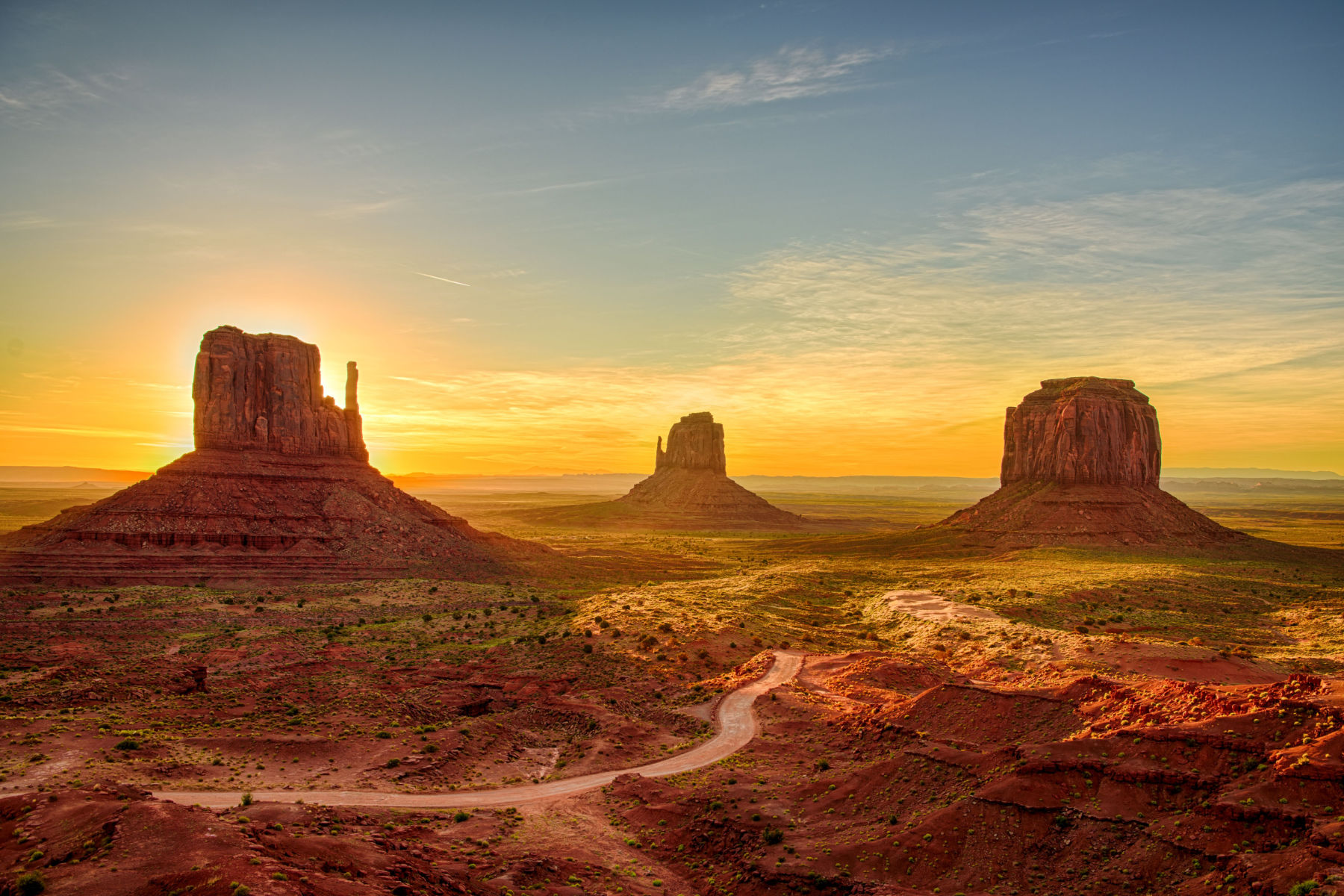
3. Arches National Park
Our next Utah landmark is a place that has the densest concentration of natural stone arches in the world. There are over 2,000 documented arches in the park, plus pinnacles, balanced rocks, fins and other geologic formations. Some are more notable than others.
At #3 on our list of the Best Utah Landmarks is Arches National Park.
For thousand of years, Native Americans lived in this region. Arches was initially designated a national monument before being changed to a national park in 1971 by President Nixon.
It’s perhaps the most interactive of all the Utah parks filled with scenery that brings out the child in all of us.
Sandstone hallways and tunnels, rocks to climb on and over, sandy trails perfect for sandals or even bare feet at times, and red rock vistas that make for an unforgettable experience.
Did you know Arches National Park has the highest concentration of sandstone arches on the planet? Or did we already mention that?
It’s close proximity to Moab does make it a bit of a crowded park at times so be sure to take advantage of early mornings when visiting and consider going during the shoulder seasons.
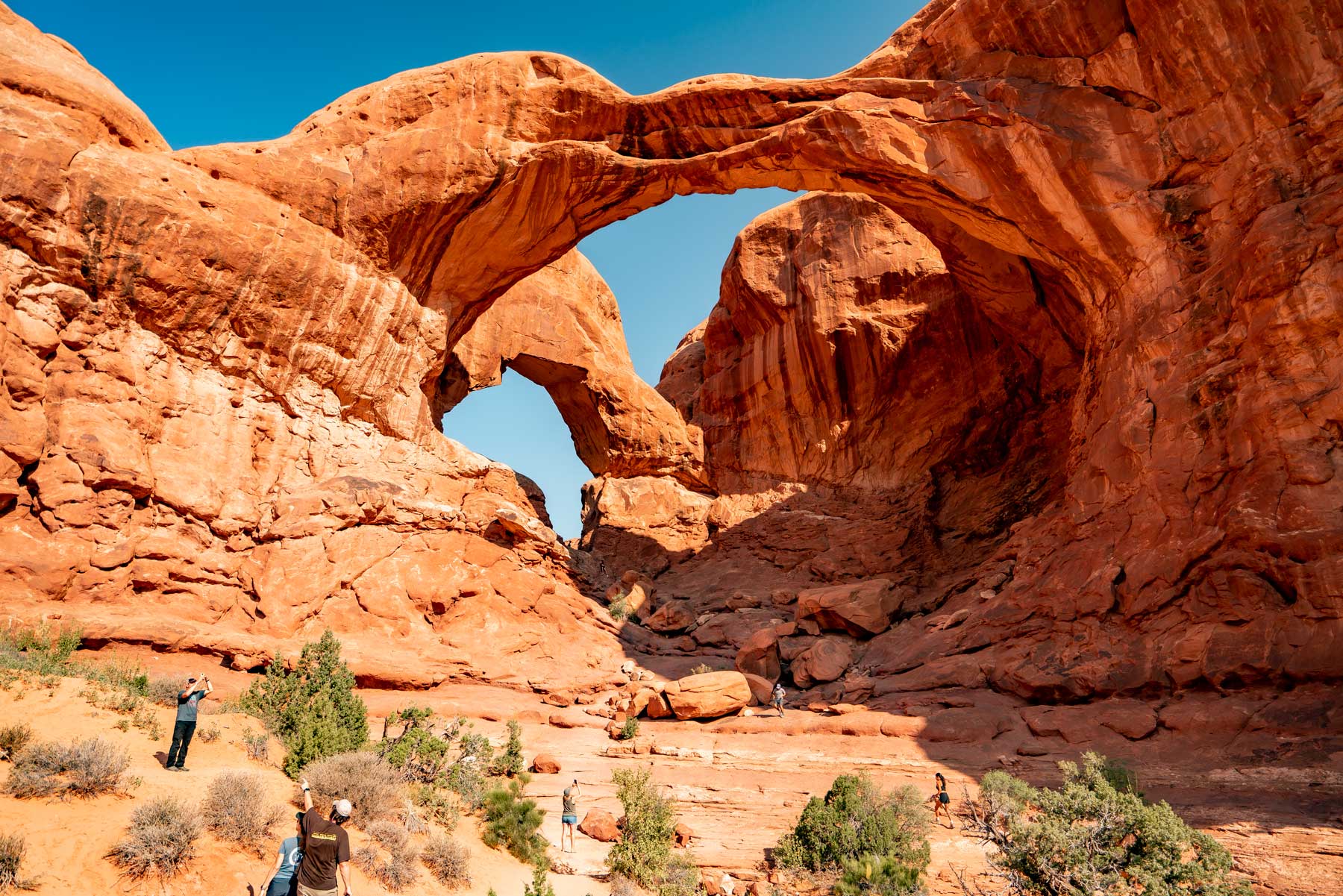
Things To Do At Arches
Here are some things you can do during your visit:
- Hiking: There are many hiking trails in Arches National Park, ranging from easy to strenuous. The most popular hikes include Delicate Arch, Devils Garden, and the Windows Loop.
- Scenic Drives: Take a drive along the park’s scenic drive, which offers breathtaking views of the rock formations and landscapes.
- Camping: There are several campgrounds in the park, including the Devils Garden Campground and the Willow Flat Campground.
- Photography: Arches National Park is a photographer’s paradise, with opportunities to capture stunning landscapes, sunsets, and starry skies.
- Rock Climbing: The park has a number of popular rock climbing areas, including the Courthouse Towers and the Fiery Furnace.
- Ranger Programs: The park offers a variety of ranger-led programs, including guided hikes, talks, and evening programs.
- Stargazing: Arches National Park is a designated dark sky park, which means that there is minimal light pollution and the night sky is incredibly clear.
- Mountain Biking: Mountain biking is allowed on some of the park’s trails, including the Klondike Bluffs and the Intrepid Trail.
- Wildlife Watching: Keep your eyes peeled for desert bighorn sheep, coyotes, and other wildlife that call the park home.
- Picnicking: There are several picnic areas in the park, including the Devils Garden picnic area and the Courthouse Towers picnic area.
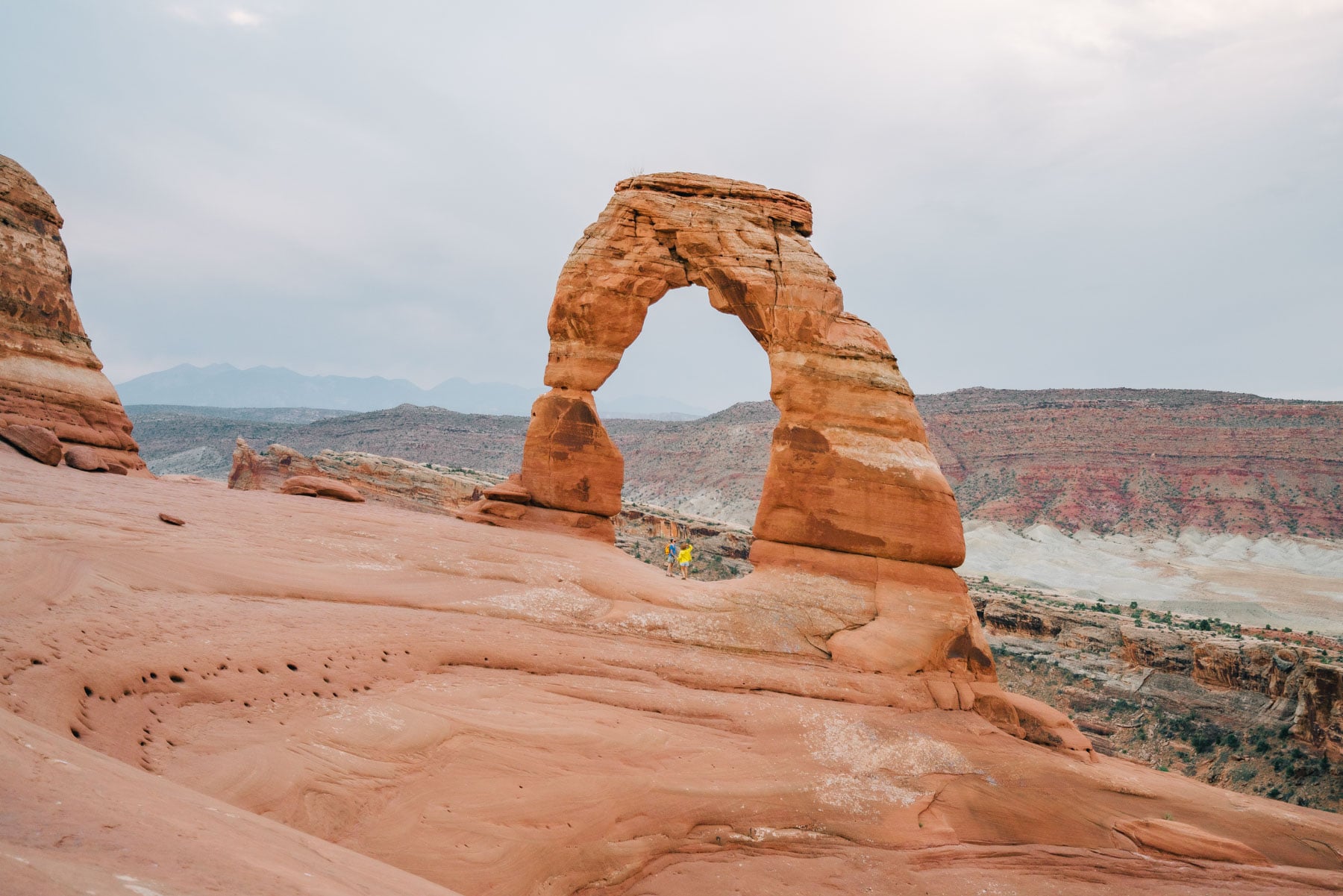
2. Grand Staircase-Escalante National Monument
We’re on to the final 2 Utah Landmarks. In the runner-up spot at #2 is Grand Staircase-Escalante National Monument.

It’s Larger Than All Of Utah’s National Parks Combined
As for Grand Staircase-Escalante National Monument, at 1.87 million acres it’s more than double the size of all 5 of Utah’s National Parks combined and every bit as spectacular.
This Rhode Island-sized national monument is a 200 million year old red rock cathedral of time.
Vast canyons, striking cliff-faces, rugged desert wilderness, and ancient history collide here making for an epic southwestern mecca.
The “staircase” steps thousands of feet over five different life zones from coniferous forests to low-lying desert revealing millions of years of truly awesome geological history.
Recreation opportunities here are seemingly endless including hiking, biking, fishing, canyoneering, climbing, rappelling, swimming, camping, backpacking, and so much more.
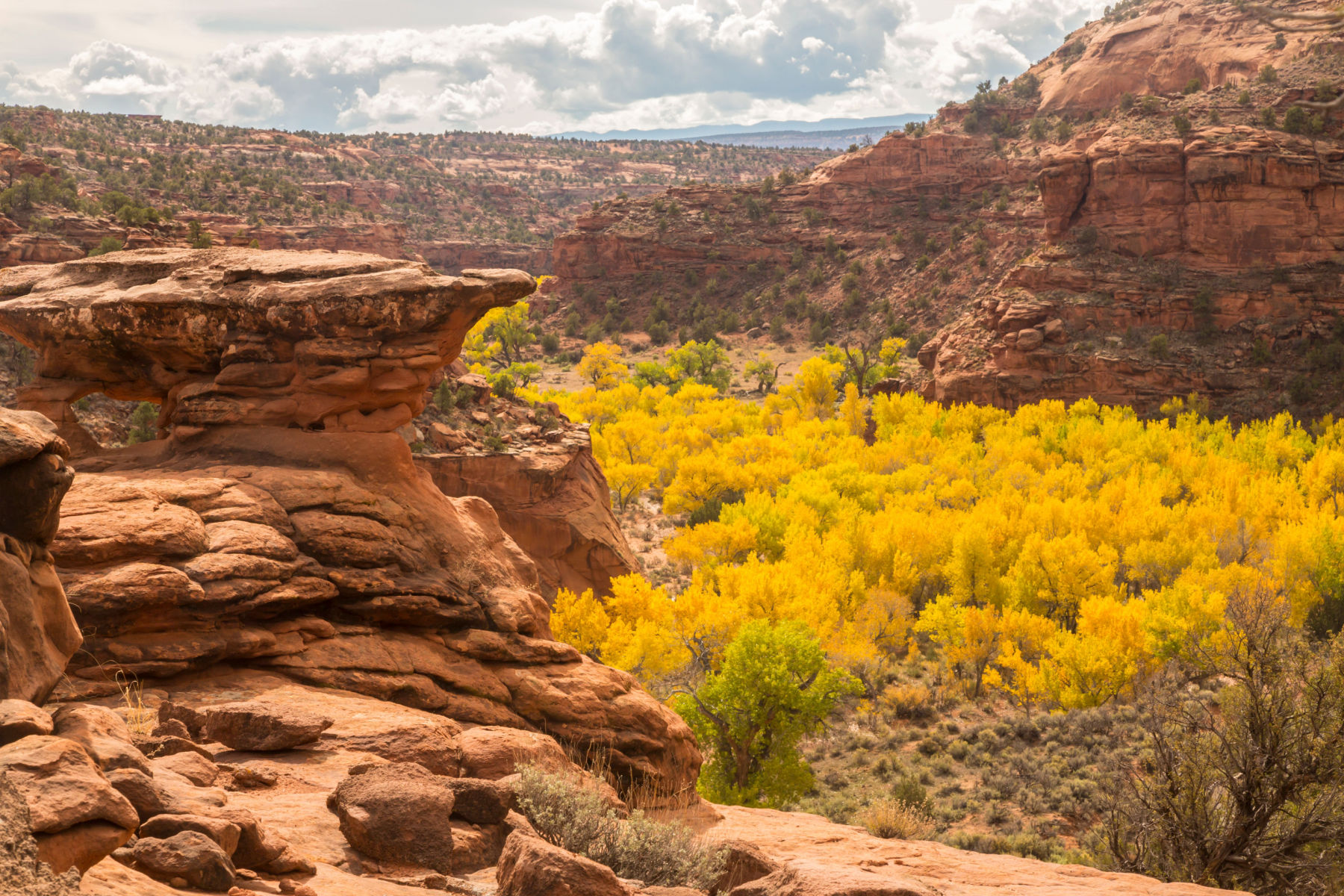
How Did It Get Its Name?
I don’t know about you, but that’s the first question I asked when I began researching this national monument.
The monument is named for the series of topographic benches and cliffs that, as its name implies, step progressively up in elevation from south to north.
As the landscape shifted over the millennia from lakes to sand dunes to rock, the Grand Staircase was formed by tectonic uplift along the Colorado Plateau, which fanned out and exposed the various layers of sediment and rock.
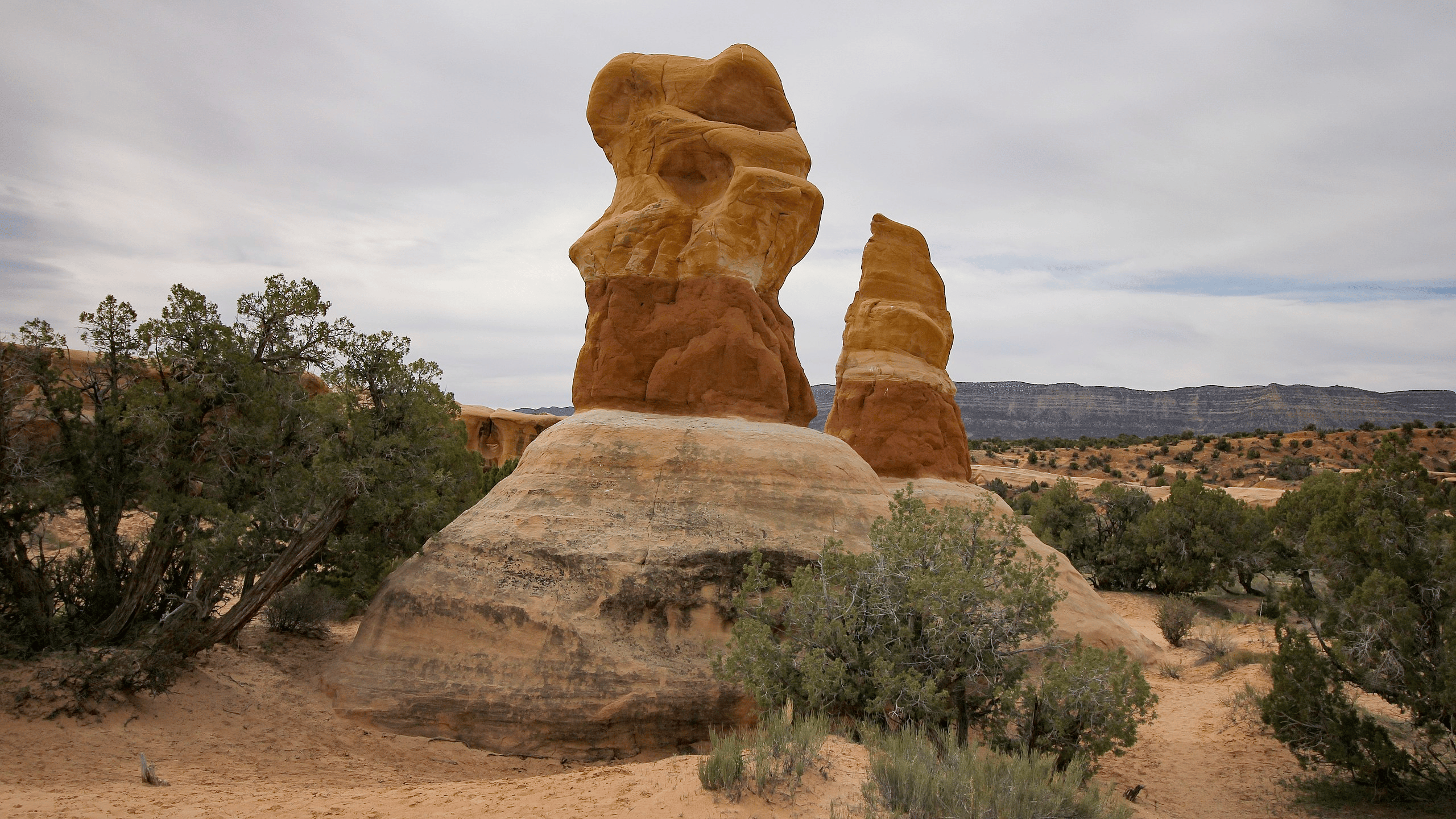
Restoring The Boundaries – Trump Strikes Again!
During his presidency, Donald Trump issued a proclamation slashing Grand Staircase–Escalante by roughly half.
This would leave nearly a million acres of federal public land open to harmful developments—such as mineral exploitation, coal mining, new road construction, the use of mechanized vehicles, and oil and gas drilling—that could ruin vital parts of this national treasure.
If you’re keeping score, The Trump Administration Rolled Back More Than 100 Environmental Rules. Here’s the Full List.
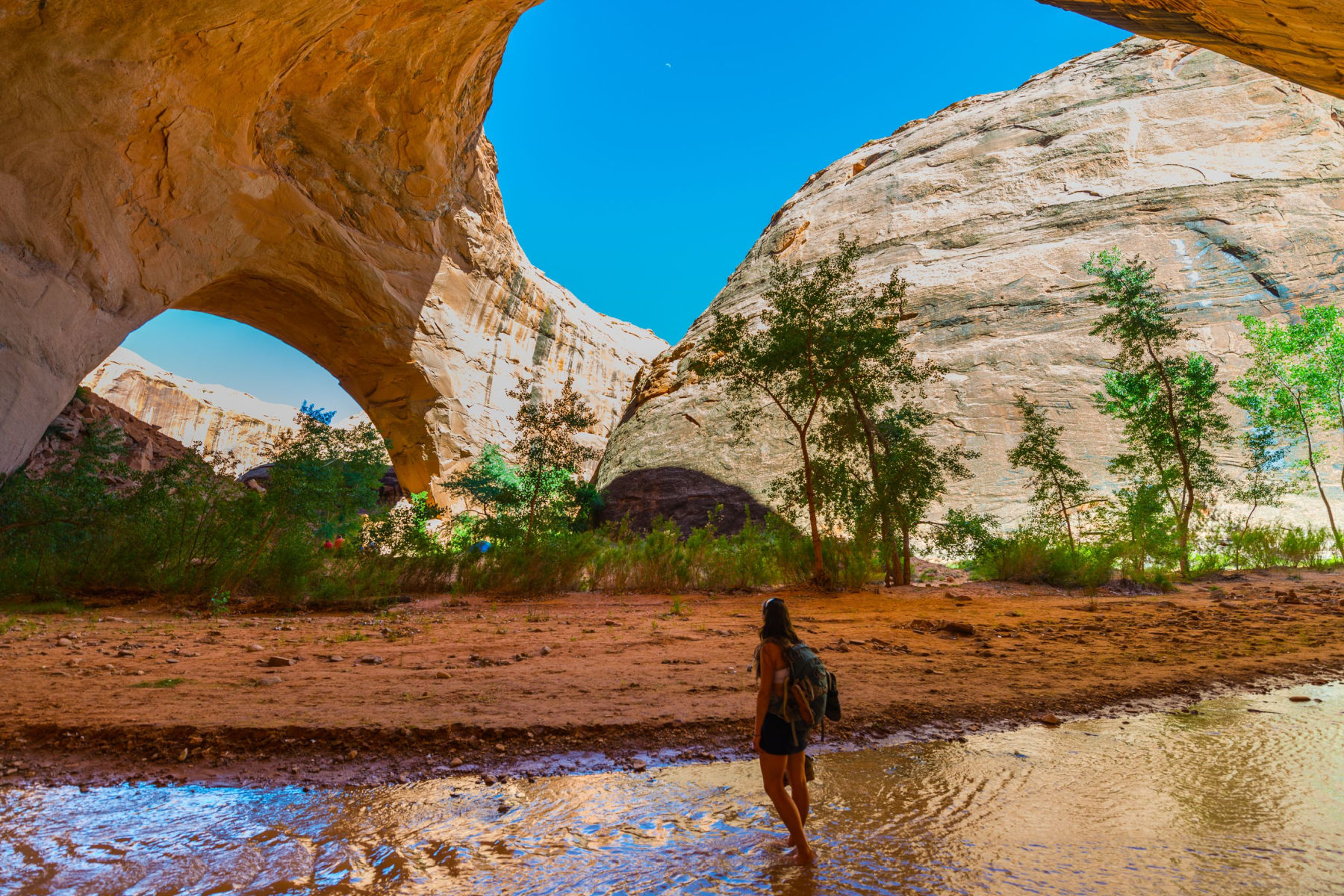
Joe Biden Rescues Another National Treasure
On Oct. 8, 2021, President Joe Biden issued Presidential Proclamation 10286 restoring the boundaries for Grand Staircase-Escalante National Monument thereby rescuing another national treasure.
Way to go, Joe!
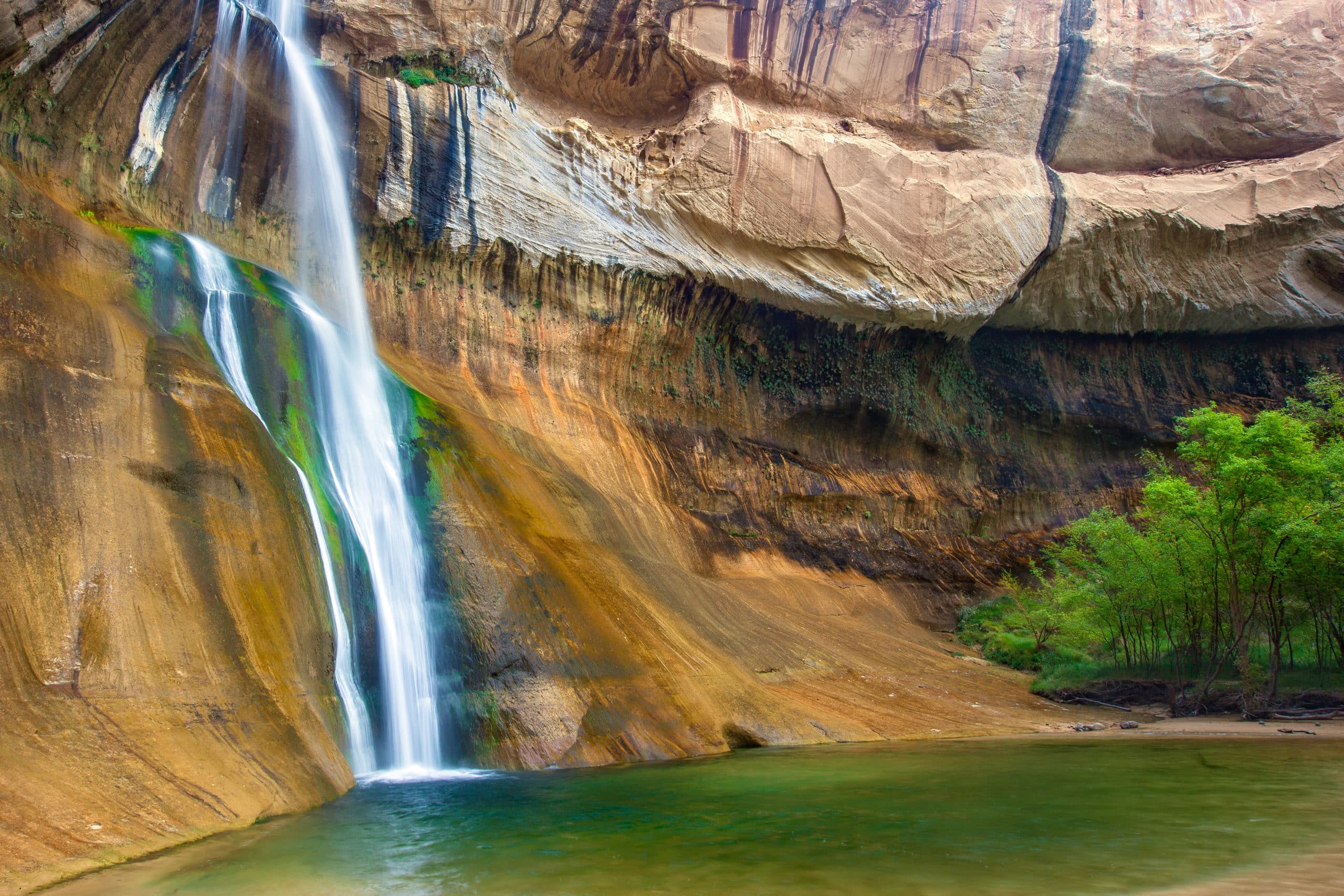
1. Zion National Park
As our #1 Utah Landmark, More Than Just Parks has chosen Zion National Park.Zion National Park’s 2,000-foot sandstone cliffs are world renowned for their big wall climbs.
The best conditions for climbing are from March through May and September through early November.
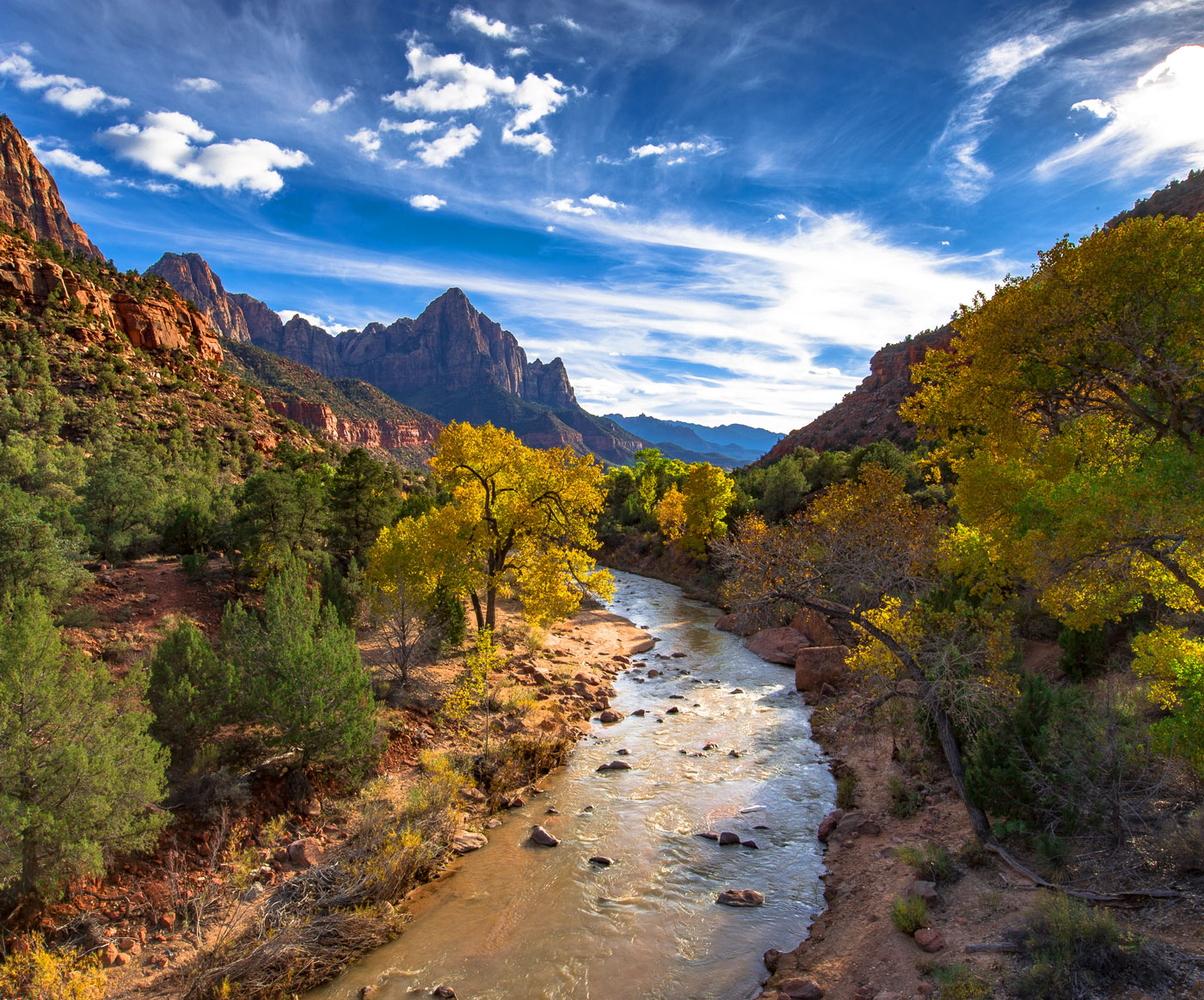
A Short History Of Zion
The land where the park is located has been inhabited by indigenous peoples for at least 8,000 years, including the Ancestral Puebloans, the Fremont, and the Southern Paiute tribes. These groups lived off the land and relied on the Virgin River, which runs through the park, for water and other resources.
In the mid-1800s, European American explorers began to venture into the area. Mormon pioneers settled in nearby communities, and some of them established farms and orchards in what is now Zion National Park. By the late 1800s, the area had become a popular destination for tourists and outdoor enthusiasts.
In the early 1900s, the National Park Service recognized the natural beauty and ecological significance of the area, and in 1909, President William Howard Taft designated it Mukuntuweap National Monument. The park’s name was changed to Zion National Monument in 1918, and it was finally given national park status in 1919.

The CCC Helped Build Many Of The Park’s Iconic Structurs & Trails
During the Great Depression of the 1930s, the Civilian Conservation Corps (CCC) helped to build many of the park’s iconic structures and trails, including the Zion-Mount Carmel Highway, the Emerald Pools Trail, and the Riverside Walk. These projects not only provided jobs for unemployed workers but also helped to preserve the natural beauty of the area.
Today, Zion National Park is one of the most popular national parks in the United States, attracting millions of visitors each year. Its dramatic red rock formations, canyons, and waterfalls continue to inspire awe and wonder, and its rich history and cultural significance are an important part of its identity.
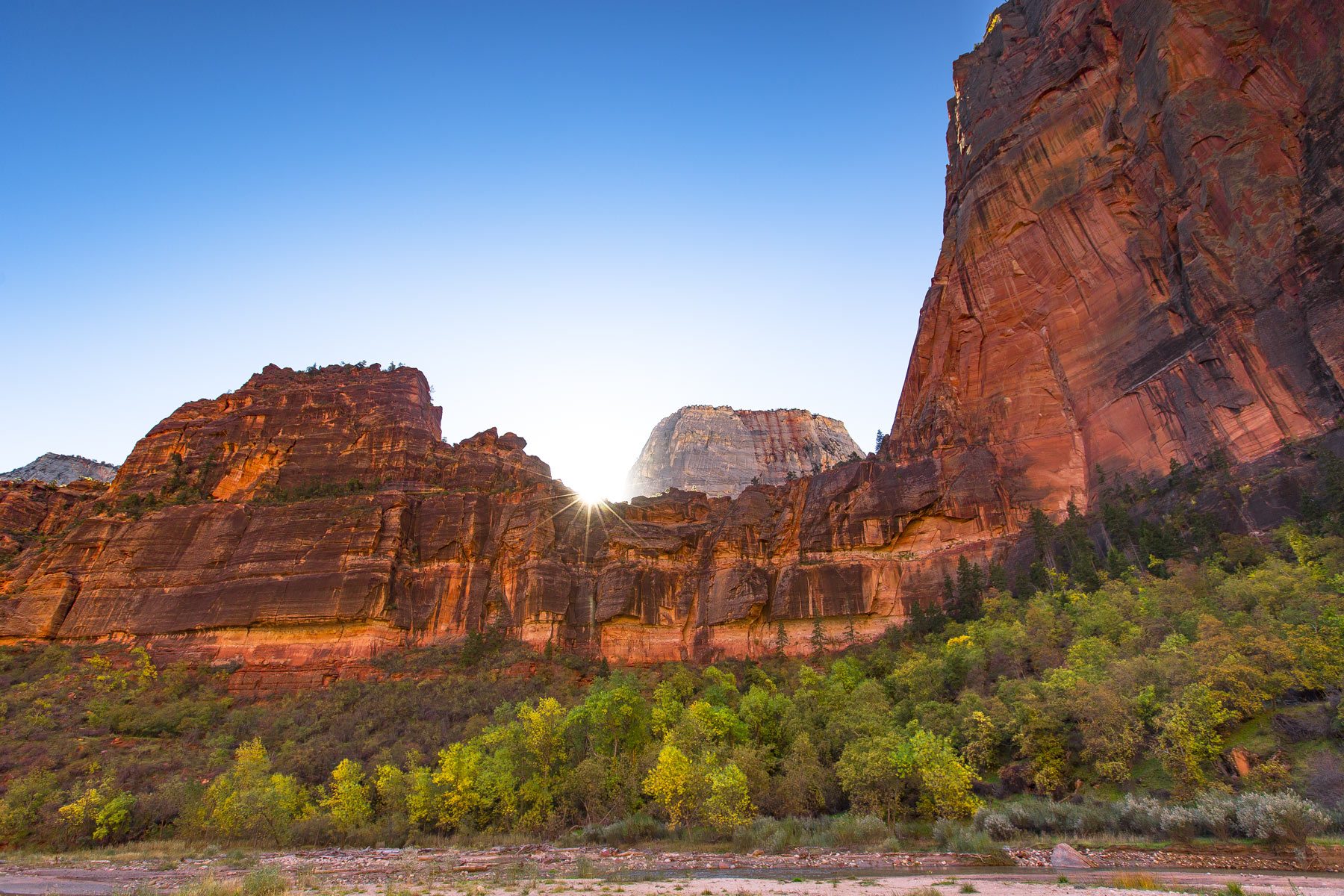
Things To Do At Zion
Zion National Park offers a variety of activities for visitors of all ages and interests. Here are some things you can do during your visit:
- Hiking: Zion National Park is known for its breathtaking hiking trails. The most popular hikes include the Narrows, Angels Landing, and the Emerald Pools Trail.
- Scenic Drives: The park’s scenic drives, including the Zion Canyon Scenic Drive and the Kolob Terrace Road, offer stunning views of the park’s natural beauty.
- Canyoneering: Experience Zion’s stunning slot canyons and waterfalls by signing up for a guided canyoneering tour.
- Rock Climbing: The park has over 1,000 routes for rock climbing, making it a world-class destination for climbers.
- Camping: There are several campgrounds in the park, including the Watchman Campground and the South Campground.
- Ranger Programs: The park offers a variety of ranger-led programs, including guided hikes, talks, and evening programs.
- Photography: With its stunning landscapes and unique geological formations, Zion National Park is a photographer’s paradise.
- Biking: Biking is allowed on the Pa’rus Trail, which offers stunning views of the park’s natural beauty.
- Horseback Riding: Guided horseback rides are available from the park’s concessionaire.
- Wildlife Watching: Keep your eyes peeled for bighorn sheep, deer, and other wildlife that call the park home.
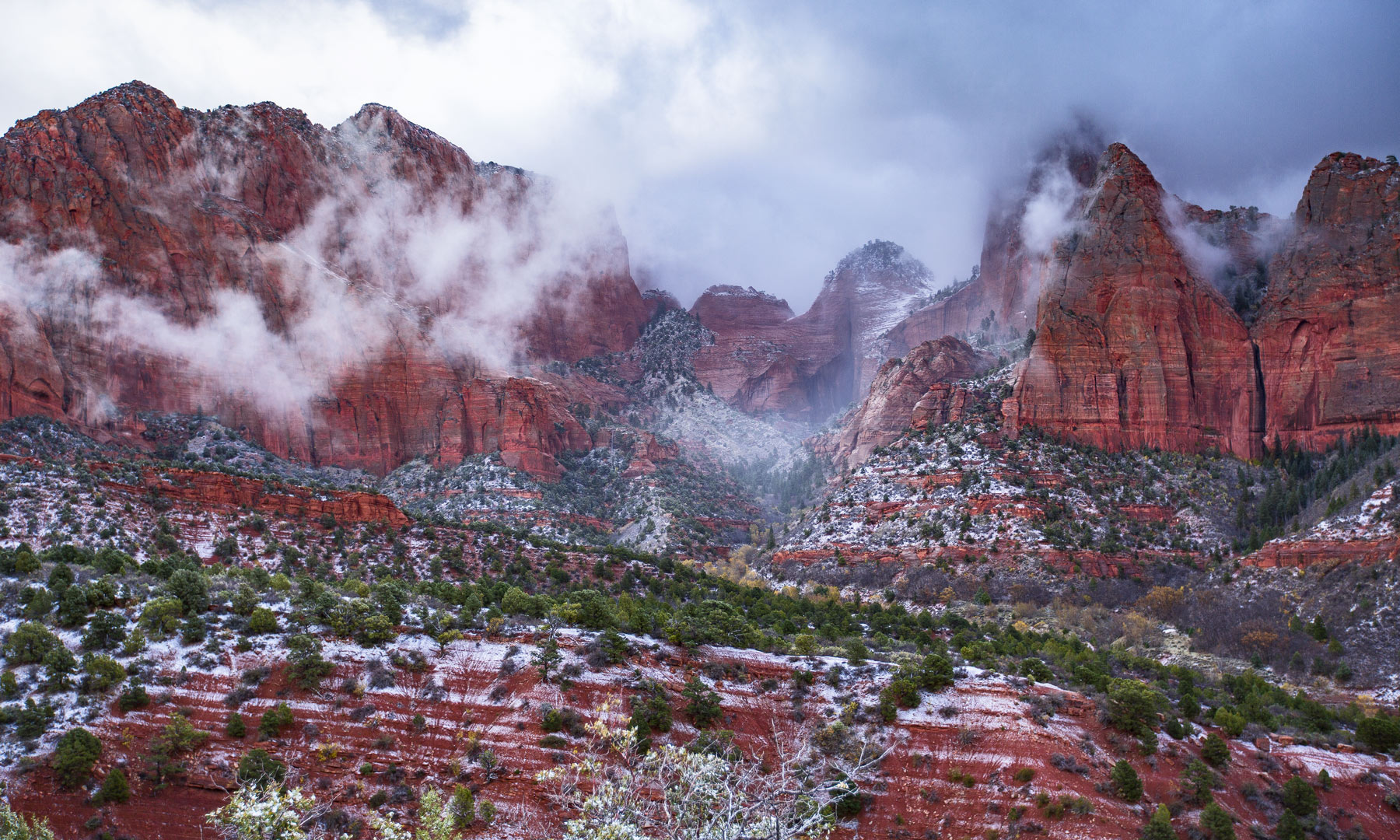
Check Out Our Zion Film
ZION is the culmination of nearly a month spent exploring Zion National Park during peak fall color. Exquisitely carved by the Virgin River over millions of years, Zion Canyon is one of the most stunning places on earth. But don’t stop there!
This park has so much more to offer outside of the main canyon. Golden meadows, sweeping vistas, red rock mountains, towering white temples, and powerful ancient rivers comprise this incredible treasure.
Filmed primarily in stunning UHD 8K. We chose to capture this film in Autumn to showcase the stunning and little known fall color of Zion National Park.
Fall is also a time when visitation dies down from peak summer months and one can find more solace in the park.
Map Of Utah Landmarks
List Of Utah Landmarks
- Zion National Park
- Grand Staircase-Escalante National Monument
- Arches National Park
- Monument Valley
- Capitol Reef National Park
- Bears Ears National Monument
- Golden Spike National Historic Site
- Dinosaur National Monument
- Parowan Gap Petroglyphs
- Natural Bridges National Monument
- Natural History Museum Of Utah
- Jurassic National Monument
- Bonneville Salt Flats
- The Beehive House
- Rainbow Bridge National Monument
- Topaz War Relocation Center
- The Place Heritage Park
- Historic South Temple Street
- Alkali Ridge
- St. Mark’s Episcopal Cathedral
Why Trust Us About Utah Landmarks?
We’re Jim Pattiz and Will Pattiz, collectively known as the Pattiz Brothers and we absolutely LOVE the national parks.
You should probably know that we don’t just make this stuff up out of thin air. We’ve spent our entire adult lives exploring and filming America’s national parks and public lands.
We’ve worked with the National Park Service, the Department of Interior, USDA, U.S. Forest Service, and more for years creating films on important places and issues. Our work has been featured in leading publications all over the world and even some people outside of our immediate family call us experts on the national parks.
And, in 2018, our father – having spent a lifetime teaching history – joined us so that he could help us to tell the stories behind these amazing places.
Meet The Parks Brothers
We Hope You’ll Follow Our Journey

Our goal here at More Than Just Parks is to share the beauty of America’s national parks and public lands through stunning short films in an effort to get Americans and the world to see the true value in land conservation.
We hope you’ll follow our journey through the parks and help us to keep them the incredible places that they are. If you’re interested joining the adventure, sign up below!
Helpful Related Articles
Things to Do Bryce Canyon: 20 Epic Things to Do in Bryce Canyon National Park
Things to Do Capitol Reef: 15 Best Things to Do in Capitol Reef National Park
Road Trip Essentials: 35+ ROAD TRIP ESSENTIALS (You’ll Love + Packing List)
Road Trip Planning Tools: 15 BEST FREE ROAD TRIP PLANNING Tools (& Apps) 2022
Zion National Park Guide: Ultimate Guide to Zion National Park
Things to Do in Zion: 18 EPIC Things to Do in Zion National Park
Best Hikes in Zion: 16 EPIC Hikes in Zion National Park
Things to Do in Arches: 16 EPIC Things to Do in Arches National Park
Utah’s Manti-La Sal National Forest: Manti-La Sal National Forest: The Forest As Beautiful as Utah’s Parks
Utah National Parks Guide: 5 MIGHTY Utah National Parks Guide
Utah National Parks Road Trips: 5 Best Utah National Park Road Trips
National Parks Rankings: ALL 63 US National Parks Ranked By Experts
Most Visited National Parks: Top 10 Most Visited National Parks
Least Visited National Parks: Top 10 Least Visited National Parks
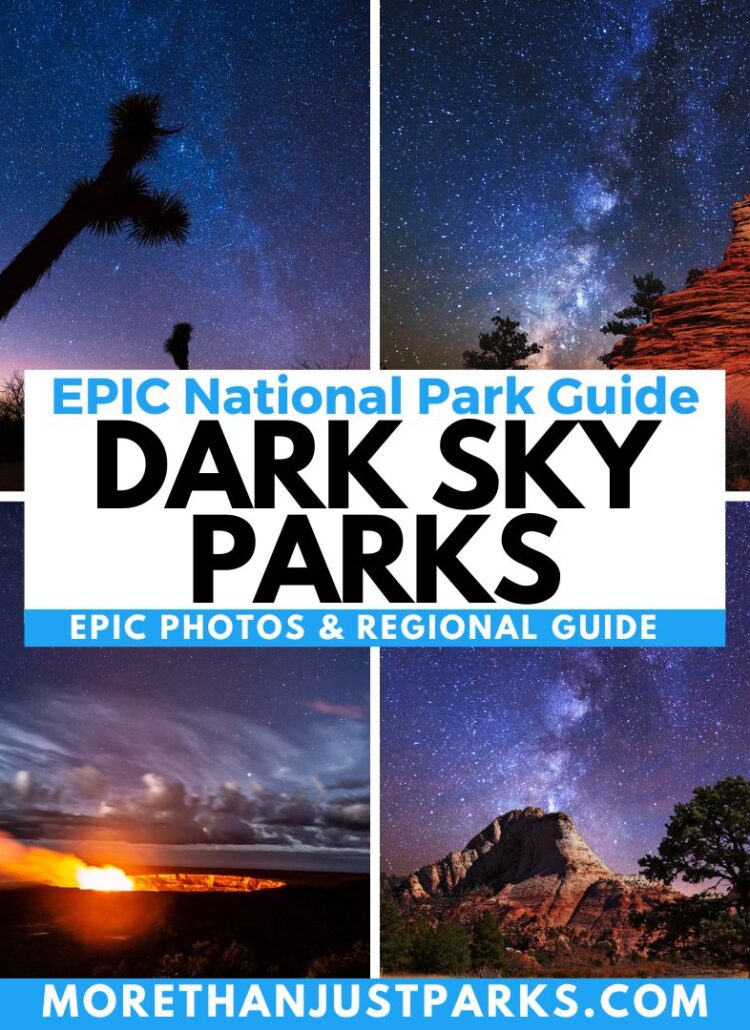
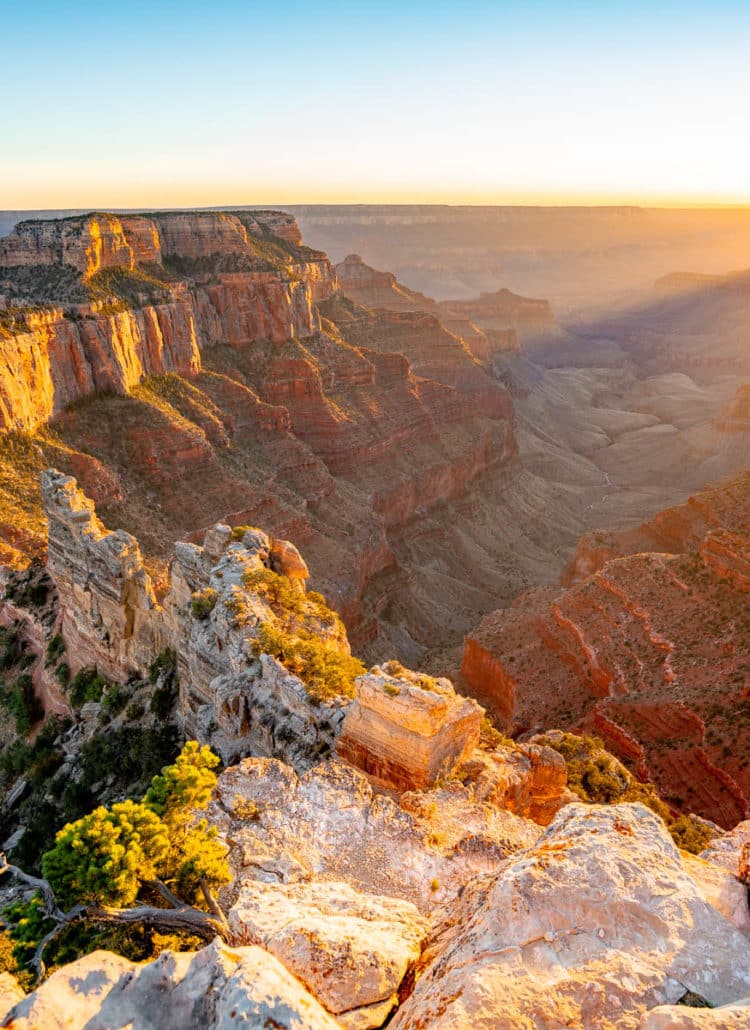
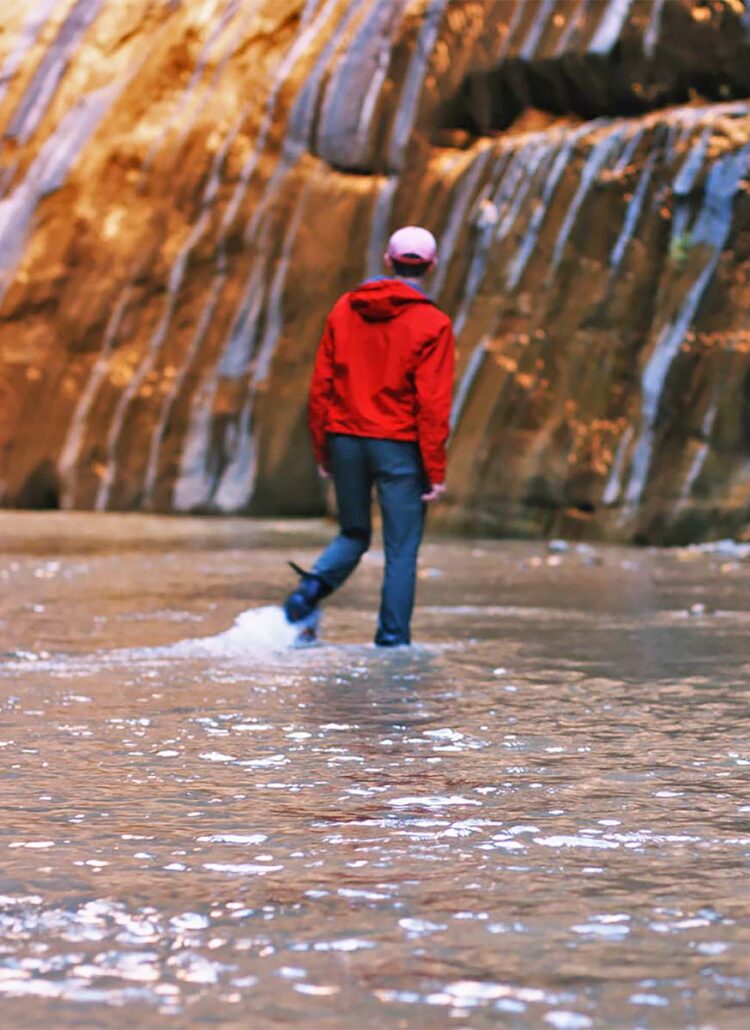
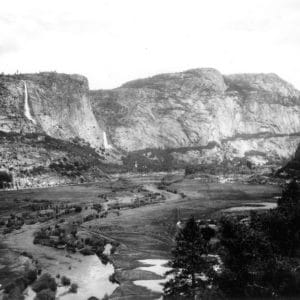

Leave a Reply